
Seeing Race
Centuries before the term “race” came into use, people categorized each other through distinctions like language, dress, geography, and religion.


Centuries before the term “race” came into use, people categorized each other through distinctions like language, dress, geography, and religion.
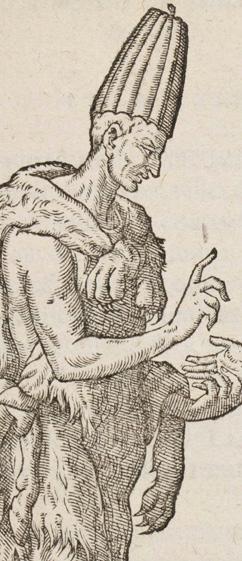

Explore the roots of race from the Middle Ages to 1800




Exhibition open through December 29, 2023
by Yasmine Hachimi
The Newberry’s latest exhibition draws on the pathbreaking work of scholars of color working on issues of race in premodern literature, history, and culture. Seeing Race Before Race shows that the history of race-making is much older and more complex than once thought. 8 16 21 26 From Antarctica to the
Marine archaeologist Mensun Bound grew up in the shadow of Sir Ernest Shackleton and his doomed Imperial Trans-Antarctic Expedition of 1914-1917. Bound recently visited the Newberry to explore our collection and share what it took to locate “the world’s most unreachable shipwreck.”
by Kara Johnson
Engaging directly with letters, photographs, and other documents is reshaping some teachers’ views on historical topics like the Great Migration, educational segregation, and post-World War II Chicago. Teaching Black History through the Archives invites educators to grapple with the questions these items raise.
Toya Wolfe, recipient of the 2023 Pattis Family Foundation Chicago Book Award at the Newberry Library, reflects on her experiences in the Robert Taylor Homes, dealing with loss, and developing the dynamic characters in her debut novel, Last Summer on State Street
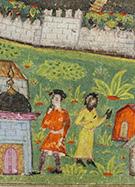

The Newberry’s seventeenth-century copy of the Tarih is a rare example of an outsider’s perspective on early modern European colonialism and its dependence on race-making. The book is a translation and adaptation of Spanish and Italian sources from the previous century, and includes descriptive texts, maps, and images of the plants, animals, and people in the Americas as imagined through Ottoman eyes.
The pages on the magazine cover—which are displayed in the Seeing Race Before Race exhibition— show an image of the mountain of Potosí in what is now modern-day Bolivia. In the foreground of the image, two figures with different skin tones interact with one another, which might refer to the use of enslaved laborers from Africa to mine silver from Potosí. The abundant use of gold in the sky and the river of silver descending from the mountain clearly alludes to the wealth that this mountain provided for Spanish colonizers.
Editors Bob Dolgan and Vince Firpo
Designer Andrea Villasenor
Photographer Catherine Gass
To make a gift and become a member, visit newberry.org/support or call (312) 255-3581.
The image helps understand why race-making was so important for Spanish colonizers. The racial diversity recognized by the Ottoman artist here had to be controlled in such a way that ensured the Spaniards would benefit from the resources of the colony instead of Indigenous people or Black Africans, which led to the creation of legal and social categories based on visible differences like skin color, religious practices, and language.
The Center for Renaissance Studies hosted an international symposium about the Tarih in June 2023 and intends to develop a collaborative interdisciplinary research project devoted to the manuscript over the coming years.
The Newberry Magazine is published semiannually. Every other issue includes the annual report for the most recently concluded fiscal year. A subscription to The Newberry Magazine is a benefit of membership in the Newberry Associates, President’s Fellows, or Next Chapter.
Unless otherwise credited, all images are from the Newberry collection or from events held at the Newberry.
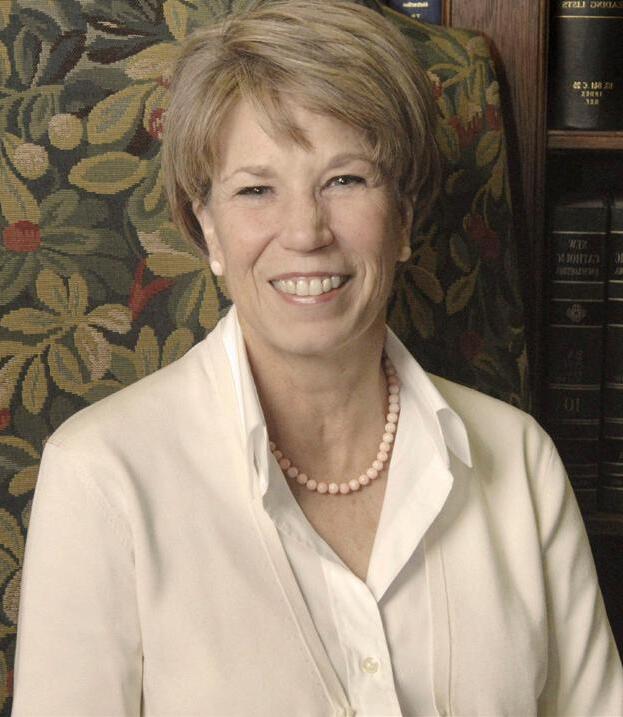
...what struck me forcibly was what I can only call Chicago attitude, or maybe it’s Chicago heart.
It was a sultry Saturday afternoon in July, midway through my Newberry tenure as Interim President and Librarian.
Surrounded by hundreds of others, I was comfortably ensconced in Ruggles Hall waiting to award the second annual Pattis Family Foundation Chicago Book Award to Toya Wolfe—a celebration preceded by a series of Chicago storytellers.
As I listened rapt to each speaker, what struck me forcibly was what I can only call Chicago attitude, or maybe it’s Chicago heart. All the speakers—one of whom was a bird puppet reminiscing about some bitter brew called Malört—had lived in the city, had been educated in the city, now lived and worked in the city. They had begun as a shampoo girl, an Asian American college professor, a girl too shy to face her public baptism, an amateur local historian, and—I guess—a baby bird puppet. But they all seemed to subscribe to the mantra of historian Sherman Dilla Thomas (“Call me Dilla”): “Everything dope about America comes from Chicago.” Embedded within the personal pride of each speaker was the good fortune of belonging to this city, a sentiment evidently shared by the audience who understood narrative arcs filled with neighborhoods, church and street names, jazz clubs, food. The names—it seemed—were new only to me.
My decade-long service on the Newberry Board of Trustees had already introduced me to Chicago civic pride, but taking up temporary residence has given that pride nuance and specificity. The Chicago flag is everywhere here. I recognize it easily now, even as I confess to having a less clear image of Washington DC’s flag—the city where I have lived, worked, and raised a family since
the 1970s. And I am beginning to understand the wry Second City bravado of Chicago’s self-portraiture—a gritty mixture of teams, weather, traffic, historical corruption, bold architecture, music, mercantilism, art, and philanthropy, all of it cooler by the lake. What I have learned is that the public-spirited ethos of the Newberry—epitomized by a policy of giving readers’ cards to anyone over age 14 and a myriad of free public offerings— is deeply reflective of the city’s open-hearted spirit. It is the Newberry’s pride in being in and of Chicago that has led to a series of upcoming exhibitions in 2024 and 2025: A Night at Mister Kelly’s , Chicago Style: Mike Royko and Windy City Journalism , Indigenous Chicago , and a show that examines immigrant printing in Chicago. The stories told by these exhibitions proclaim the city’s diversity—past, present, and future—and highlight the extraordinarily rich archives that are indispensable for such storytelling.
I am indebted to the Newberry staff and the Newberry public for this experience, with its deep rewards of insight into the workings of a world-class library and its Chicago roots. As I look at the small bust of Carl Sandburg sitting on a windowsill in the President’s office, a familiar line from his poem “Chicago” comes to mind—“show me another city with lifted head singing so proud to be alive.” And now I understand why.
Notable happenings around the Newberry. We are always growing and changing. Grounded in history, engaged with the present, looking to the future.

ANNOUNCEMENT

The Newberry Library is pleased to announce the appointment of Astrida Orle Tantillo as its tenth President and Librarian. Tantillo was named following an international search that employed the executive search firm Isaacson, Miller. She joins the Newberry from the University of Illinois Chicago (UIC), where she served as Dean of the College of Liberal Arts and Sciences (LAS) from 2012 to 2022 and is currently Professor of Germanic Studies and History. As Dean, Tantillo oversaw a budget of $100 million, 25 academic departments and programs, approximately 700 tenure and non-tenure track faculty members, and more than 200 staff members. She was recruited to the Newberry’s Board of Trustees in 2022 due to her extensive experience in academic administration in Chicago.
During her tenure, LAS supported a variety of new centers and initiatives, including the Freshwater Lab, an interdisciplinary freshwater policy and research initiative; the Inter-University Program for Latino Research/UIC Mellon Fellows Program; and the Center for LatinX Literature of the Americas. She raised
$50 million as part of IGNITE: The Campaign for UIC, while strategically investing in faculty hiring, recruitment and retention, and expanding the number of endowed chairs and professorships. She strengthened and expanded collaborations with cultural institutions including the Field Museum and Chicago Humanities.
“Astrida is a proven leader, fundraiser, and scholar with a wealth of experience managing a complex organization,” said Robert A. Holland, Chair of the Newberry’s Board of Trustees. “She is well-positioned to lead this next chapter in the Newberry’s history.”
Tantillo is a humanities scholar, having authored three books on Goethe, including Goethe’s Modernisms , The Will to Create: Goethe’s Philosophy of Nature , and Goethe’s Elective Affinities and the Critics. Tantillo earned her PhD from the University of Chicago’s Committee on Social Thought and her BA from the University of Oregon Honors College.
Tantillo will join the Newberry on December 1, 2023, succeeding Gail Kern Paster, who has led the library on an interim basis since April 2023.
Alice Schreyer, who joined the Newberry in 2015, has retired as Roger and Julie Baskes Vice President for Collections and Library Services. Among Alice’s many successes was the acquisition of the Curt Teich Postcard Collection, which prompted the library to make postcards one of its core collections. Additionally, Alice has been recognized for her focus on digital initiatives, from overseeing improvements to the online catalog to launching a new digital asset management system that will improve accessibility for researchers. Alice’s leadership of the Collection Development Steering Committee brought teams and disciplines together to identify acquisitions that align with the Newberry’s collection. Prior to joining the Newberry, Alice had a lengthy tenure at the University of Chicago Library serving in a number of roles including Curator and Director of Special Collections.
In honor of Alice’s retirement, the Newberry acquired a rare book to add to its collection. The bound volume contains eleven eighteenth-century print and manuscript items, assembled by their original owner in Spain. Although outwardly unassuming, it includes controversial and forbidden items relating to the spread of French Revolutionary ideas to the Spanish empire. Chief among these is a very rare and ephemeral (but very important) printed leaflet in Spanish in support of the French Revolution from 1792— almost certainly the first such item printed in France for Spanish readers. Additionally, an early manuscript translation into Spanish of the 1789 Déclaration des droits de l’Homme et du citoyen (Declaration of the Rights of Man and of the Citizen) is one of the fundamental texts for the development of ideas of human rights and democracy around the world. Both texts had been immediately banned and furiously suppressed by Spanish officials.

Additional contents include a manuscript treatise on agricultural reforms and wine grape cultivation by a well-known Spanish poet, Felix de Samaniego; two important and lengthy letters from economist and Enlightenment thinker Valentín de Foronda; and a rare 1790 pamphlet describing methods of combating airborne diseases. The original compiler of the volume has not been definitively identified but was almost certainly from the Basque country in northern Spain.
The purchase of the volume was funded by a group of generous donors and the Newberry’s Society of Collectors as a fitting tribute to Alice’s storied career.
Nominations are now open for The Pattis Family Foundation Chicago Book Award, presented annually to a book that transforms public understanding of Chicago, its history, or its people. The annual award, established in 2021, recognizes fiction or nonfiction works that resonate with the Newberry’s collection strengths. The award includes a prize of $25,000, which has quickly placed it among the most coveted local literary honors. Nominations must be submitted through the Newberry’s website by January 31, 2024.
Matt Rutherford, Curator of Genealogy and Local History, has been selected as the 2023 recipient of the National Genealogical Society’s Filby Award for Genealogical Librarianship. The award honors Matt’s “leadership and service to the genealogists, family historians, and library patrons at the Newberry Library and throughout [his] career.” The highest honor for librarians whose primary focus is genealogy and local history, the Filby Award has been granted annually since 1999. Matt became the Newberry’s Curator of Genealogy and Local History in 2009, having previously served as Reference Librarian for Local and Family History since 2004. With Jack Simpson, he co-authored A Bibliography of African-American Family History at the Newberry Library in 2005. Matt has helped thousands of Newberry readers with their genealogical research at the library and thousands more via email and other correspondence, as well as in his teaching Newberry classes on genealogy and the writing of research guides and blog posts.


Will Hansen has been named the Newberry’s Roger and Julie Baskes Vice President for Collections and Library Services following a lengthy tenure at the library as Director of Reader Services. In addition to his role as Curator of Americana, Will’s responsibilities as Vice President include oversight of the Newberry’s Collection Development, Collection Services, Conservation, Digital Initiatives and Services, Maps, Modern Manuscripts, and Reader Services departments. Will began his career at the Newberry from 2003 to 2007 and returned to the organization in 2014 after a seven-year tenure at Duke University’s David M. Rubenstein Rare Book & Manuscript Library.

Instruction and Outreach Librarian Lisa Schoblasky recently became Director of Reader Services after more than 20 years at the Newberry. As part of her role, Lisa is responsible for reading room operations and Reference Services. Additional duties include revising and expanding instruction services at the library, diversifying instruction offerings for class visits, and promoting the library’s holdings alongside the Research and Education and Public Engagement divisions. Lisa serves as co-chair of the library’s Diversity, Equity, and Inclusion Committee.
“Between staff and researchers he worked with before—and even after—his retirement, John’s career intersects in some way with nearly the entire 136-year history of the Newberry.”
At a summer staff party in the early 2010s, Newberry employees were encouraged to play a round of a new game: Stump John Aubrey. John Aubrey, then Ayer Librarian at the Newberry, sat before his colleagues as they asked him question after question about the library’s immense collection. True to lore, it was nearly impossible to land on a corner of the archive that was unknown to John. For he, as staff and readers often remarked in awe, “knew everything.”
The Newberry lost a beloved and exceptionally knowledgeable member of our community in May when John passed away at the age of 89. John served as the Ayer Librarian for an incredible 45-year run, from 1969 to 2014. His contributions to the Newberry, its readers, and the scholarship that grows from our collections are nearly impossible to summarize. His name appears again and again in the acknowledgments of at least two generations of scholarship in American Indian history from the 1970s to 2010s. He made immense contributions to the strength of the Edward E. Ayer Collection as curator. His knowledge of the Newberry and service-oriented spirit live on in the current Ayer Librarian, Analú López, and the many current Newberry staff members whom John helped to train. But even those facts do not entirely convey the extent of his impact at the Newberry.
“Between staff and researchers he worked with before— and even after—his retirement, John’s career intersects in some way with nearly the entire 136-year history of the Newberry. To this day we have researchers who mention a man who showed them a book 20 or 30 or 40 years ago that they hope to find again. They are almost always referring to John,” recalls Will Hansen, Roger and Julie Baskes Vice President for Collections and Library Services.
This broad and deep knowledge of the collection stemmed from John’s real interest in all manner of inquiry and his willingness to help readers, fellows, and staff deepen their understanding of a particular topic. He truly listened to those who came to him for guidance, and found great pleasure in helping them navigate the Newberry’s vast holdings.
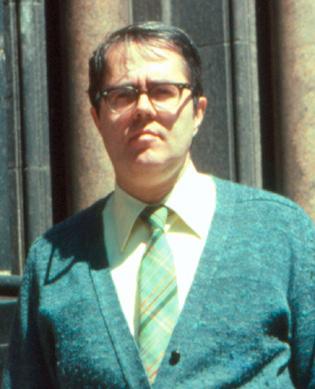

“John never lost his curiosity or interest in pursuing topics from the obscure to pop culture and everything in between,” recalls his wife, Karen Aubrey, whom he met while they both worked at the Newberry. “He liked asking folks where they were from and when they replied, he usually had knowledge of their place of origin—whether a small town in Russia or a neighborhood in a large city. When I asked him how he knew these things, he’d smile, glance down and say, ‘I read a lot.’”
The Newberry’s long history is peopled with legendary characters that exemplify the curiosity, openness, and intellectual rigor of the library. John Aubrey, with his gentle nature and unmistakable knit cap, sits near the top of that list.


“We will miss John’s presence at the Newberry,” says Hansen. “We miss seeing him at a computer in the reading room, chasing down a citation, or printing out an archaeological report. I also miss him asking after my family, or chatting about Midwestern potato chip brands, or helping me track down an obscure illustration in a 300-year-old book. But John’s presence will always be felt here at the Newberry, in ways big and small.”

By Yasmine Hachimi

Race—how it’s made, figured, mapped, and performed—is at the center of Seeing Race Before Race, a new exhibition at the Newberry Library that explores the roots of race from the Middle Ages to 1800. While in recent years there have been exhibitions focused on the African presence in Europe, Seeing Race is one of the first exhibitions at a cultural institution in the United States to examine the origins of race through the visual and material culture of this period. Centuries before the term “race” came into use, people categorized each other through distinctions like language, dress, class, geography, and religion, in addition to traits like skin color or facial features. Drawing on the Newberry’s vast collections, as well as items loaned courtesy of the Art Institute of Chicago, Adler Planetarium, and the Carl & Marilynn Thoma Foundation, the exhibition features maps, manuscripts, printed books, paintings, woodcuts, and even a clockwork automaton—all dating from 1100 to 1800. While the exhibition presents histories from various parts of the world, it focuses primarily on “Western” perspectives because the system of race that we experience today largely developed through the decisions, ideas, and actions of premodern Europeans. Furthermore, the Newberry’s collection is largely comprised of materials from Europe and the Americas.
“My hope is that this exhibition will help broad publics discover a history of race-making that is much older and more complex than they thought, and that seeing how race was made might help them imagine a world otherwise.” — Noémie Ndiaye
I joined the Newberry’s Center for Renaissance Studies (CRS) last fall as Public Humanities Postdoctoral Fellow to work on the exhibition. I had just finished graduate school and was eager to learn the ins and outs of curation, while also exploring how race and racial thinking are represented in the material culture of the past. I knew that the Newberry had extensive archives, but I was excited to find out that their collections included such rich materials about race-making in the premodern period.
Seeing Race Before Race draws on the pathbreaking work of the RaceB4Race research collective, an ongoing conference series and professional network community created by and for scholars of color working on issues of race in premodern literature, history, and culture. The partnership between the RaceB4Race collective and the Newberry began when Rebecca L. Fall, co-curator of the exhibition and Program Manager of the CRS, reached out to RaceB4Race Executive Board Member Kim F. Hall to inquire how the Newberry could lend its resources and support the collective’s important work. Hall suggested connecting with Noémie Ndiaye, Associate Professor of Renaissance and Early Modern English Literature at the University of Chicago, then a fellow Executive Board Member of RaceB4Race.
As Ndiaye connected with staff at the Newberry, an idea began to take shape. The exhibition would not tell just one story about race—the concept was too complex for that. Instead, the goal was to use Newberry materials to help visitors see multiple definitions of race and understand how they changed in different times and places. The exhibition would not only show the violence of premodern racial oppression, but also moments of resistance, especially from communities of color. Describing her goals for the project, Ndiaye says, “My hope is that this exhibition will help broad publics discover a history of race-making that is much older and more complex than they thought, and that seeing how race was made might help them imagine a world otherwise. I also hope it will signal to Premodern Critical Race scholars that the Newberry and Chicago more generally are emerging as a key center for our field.”
One of the reasons I was interested in working on this exhibition is the partnership between the Center for Renaissance Studies and the RaceB4Race collective—a collective of which I have been a part for several years. The intense collaboration at the heart of the Seeing Race Before Race exhibition aligned with my own values and practices as an academic, and intersected with my expertise in Premodern Critical Race Studies and translating academic research for a variety of publics. The process of curating an exhibition is collaborative by nature, and we found ways of making that process even more inclusive and expansive in order to meet our goal of centering the work of BIPOC (Black, Indigenous, and people of color) scholars. This included reaching out to a diverse body of graduate students, early career scholars, and senior scholars to contribute to the exhibition catalog; soliciting readers outside of the
Newberry and academia to read and provide feedback on our wall text and labels; and creating learning resources for teachers relating to recently unearthed materials on premodern race-making in the Newberry’s collection. We estimate that over one hundred people have worked on this exhibition in some way, shape, or form.
Prior to my arrival in Chicago, the curatorial team had already completed the painstaking work of selecting the items that would be on view in the galleries. When I asked about that process, I learned that they began looking at collection materials in early 2020, when the world was shut down due to the

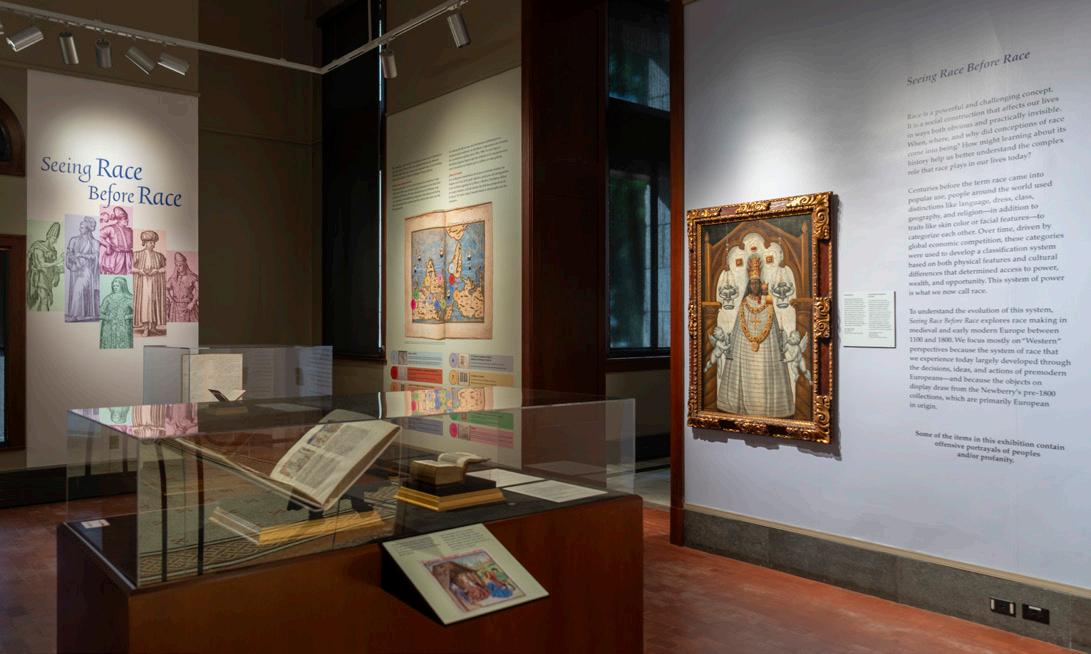
Hearing about this challenging process, I was struck by the contrast my co-curators described: encountering vivid moments of contact in the past during a period of isolation in the present.
While the world was grappling with the pandemic, the horrific murders of Ahmaud Arbery, Breonna Taylor, and George Floyd prompted a national reckoning over racial injustice. This greatly impacted public conversation on race and racism and prompted a resounding call for social change. How daunting it must have been for the curatorial team to examine materials showing early examples of racial profiling at the same time that national discussions about racial profiling and police brutality against the Black community were increasing. As Lia Markey, Director of the Center for Renaissance Studies and co-curator of the exhibition, has said, “The events of that summer confirmed that the team’s work on an exhibition dealing with the early foundations of today’s racial system was both urgent and necessary.”
The curatorial team kept up their work in the face of the pandemic and civil unrest in order to open Seeing Race Before Race in the fall of 2023. The exhibition is organized into four sections: Making Race, Figuring Race, Mapping Race, and Performing Race . Each section was designed to guide visitors through the different ways that premodern people imagined, interpreted, and experienced race and racial difference. Making Race provides an overview of the exhibition and how race was made in the premodern period; Figuring Race focuses on racialized bodies and appearances; Mapping Race shows how space is used as a way of exerting power; and Performing Race allows us to think about how race affects our behavior.

Race is a social construct that emerged from decisions that artists, authorities, and ordinary people made—sometimes unknowingly and sometimes intentionally—to define themselves in relation to others. They creatively combined ideas, images, and customs to imagine new social categories and practices that validated their place in the world. Medieval and early modern Europeans made these decisions over and over again. Over time, they produced widely shared assumptions about different groups of people that were used to give certain communities legal, social, and economic advantages over others. In other words, they made race.
Before entering the exhibition gallery, visitors will notice two figures on the glass doors of the entrance. One is an “enslaved Moor” and one is a Jewish woman. They look as though they’ve been plucked straight out of the pages of an early printed book. As the doors to the gallery open, one can see the Moor alongside four more figures, each outlined and tinted with a bold color. Our designers used figures from Nicholas de Nicolay’s travel narrative to emphasize the humanity of the figures and the vibrancy of the past. I like to think of them as an artistic expression of going from black and white to color; from “race didn’t exist in the past” and “I don’t see color” to a myriad of figures highlighted in vibrant colors not only to ensure that we see them, but also to remind us that race did indeed exist in the past.
The introductory gallery of Seeing Race Before Race shows examples of how premodern people made race. The earliest example of race-making is a Franciscan Bible printed in Paris, France, in the mid-thirteenth century. The Bible mentions Black figures like the “Ethiopian man” who was converted to Christianity by the apostle Philip in the Book of Acts. The Franciscan Bible is encased alongside a beautifully illuminated manuscript of Le miroir de humaine saluation (The mirror of human salvation), made in 1455. The pages of this luxury manuscript are open to a colorful scene of the Three Wise Men visiting the Christ child. According to co-curator and Assistant Director of the Center for Renaissance Studies Christopher Fletcher, “These two books help remind us that recognizing differences between people goes back a long way. The Bible shows that racial diversity, even just the idea of it, was always present in the European imagination through Christianity, and the Miroir proves that medieval artists often chose to represent it for European audiences. Each time they did, those choices remade race all over again.”
The second and largest room in the exhibition opens with Figuring Race. “Figuring” has a dual meaning here. It refers to how bodies are drawn and to how people figure themselves and the people around them in society. The materials in this section show how premodern people understood and visualized the concept of race through depictions of the human body in drawings,

Albrecht Dürer’s The Four Books of Human Proportion, an instructional manual designed to aid artists in drawing different human figures, displays the profiles of several male figures, each with different exaggerated features, 1577.
paintings, printed images, and poetry. Figures were copied, reproduced, and circulated widely, which helped standardize the ways people saw and understood racial difference over centuries.
Art was one vehicle through which ideas about race and race-making circulated across premodern Europe. For example, Albrecht Dürer’s The Four Books of Human Proportion , an instructional manual designed to aid artists in drawing different human figures, displays the profiles of several male figures, each with different exaggerated features. Dürer notes that European faces are more beautiful than African faces. Together, the images and texts emphasize the idea that facial and cranial measurements were supposed to be indicative of personal character and ethnic origin. First published in German in 1528, this book was translated into five languages, and issued in more than 15 editions (including the French, Italian, and German editions in the Newberry collection). The popularity of Dürer’s work shows how images about people of color are repeated or reconfigured across time, reinforcing harmful stereotypes.
Dürer’s manual is displayed next to Nicholas de Nicolay’s travel narrative of voyages to Turkey—the same work featured on the exhibition’s doors. Printed in 1576 with letterpress and engravings, the travel narrative uses clothing as an example of racial identity. We chose images from Nicolay’s book for promotional materials for the exhibition because the highly illustrated text features a variety of people from different countries labeled with information about their socio-economic backgrounds and religions.
While writing labels for the exhibition, we realized there were several items, like the Dürer manual, that we wanted to discuss in greater detail. How could we give these items the attention and context they deserved without overwhelming exhibition visitors? We produced a digital interactive “StoryMap” called Seeing Race Before Race: A Closer Look in collaboration with the Newberry’s Digital Initiatives and Services team; it can be found in our exhibition gallery and online at digital.newberry.org/rb4r


Another way that race was made in the premodern period was through maps. Historical maps, a major strength of the Newberry’s collection, often reveal ongoing contests for power and influence. Through maps, atlases, and travel narratives, medieval and early modern cartographers familiarized a wide range of audiences with what seemed like a rapidly expanding world. But what may have appeared as a simple means of sharing new information was also a way for white Europeans to claim political and economic control over lands that were not their own. In doing so, they often established exclusionary borders and represented non-Europeans on the maps as wild or exotic.
Our first public program to support the exhibition, “Understanding Race: Past & Present,” featured a dynamic conversation between award-winning scholars Olivette Otele, Distinguished Professor of the Legacies and Memory of Slavery at the University of London’s School of Oriental and African Studies, and Noémie Ndiaye. While discussing the exhibition, Dr. Otele mentioned that one of her favorite items in the exhibition is the enormous and colorfully painted map of Africa dating to 1730 and produced by Nicolas de Fer. In addition to mapping the continent of Africa, it also displays inhabitants from different regions through text and image along the outer edges of the map. These vignettes showcase the diverse dress, skin tones, crafts, and
resources of Africa for elite European viewers in order to inspire consumption and colonization. The map had always been on view in a hallway outside the Newberry’s Special Collections Reading Room, but its journey to the galleries allows even more visitors to see it—and in an entirely new way.
The de Fer map shares the north wall of the large gallery with an Indigenous map of the Tultepec and Jaltocán regions in Mexico. This map was used in the sixteenth century by Indigenous Nahua farmers to win a legal dispute about the boundaries of a community in colonial Mexico. The farmers were protecting Indigenous food supplies that were being destroyed by the livestock of a Spanish rancher named Juan Antonio Covarrubias. The map, which combines Native glyphs and Spanish writing, was painted on amatl , a paper made from tree bark using Indigenous traditions practiced long before the Spanish invasion. We put an Indigenous map next to a European map to show how Europeans thought about places and people beyond their own country, as well as how Indigenous people viewed themselves and the land in relation to colonizers—and to show that the Nahua people who created the map understood that mapping represented a key form of power to European authorities. While the de Fer map was a tool to encourage colonization, the map of the Tultepec and Jaltocán regions was a form of resistance that helped the Indigenous farmers to win their case against Covarrubias.
When we think about how race is performed, we often think about how it is performed under the bright lights of a stage. The Performing Race section of the exhibition highlights how ideas about race affect the way we act in the world both on and off stage. The materials in this section focus on how medieval and early modern people, primarily Europeans, learned to “perform” racial identity—including whiteness. Whether on stage, at court, or in everyday social settings, people learned not only how to behave according to evolving beliefs about race, but also how to ascribe cultural value and power to different behaviors. In time, these behaviors were practiced so often that they started to seem natural, like a product of inherent difference rather than careful performance.
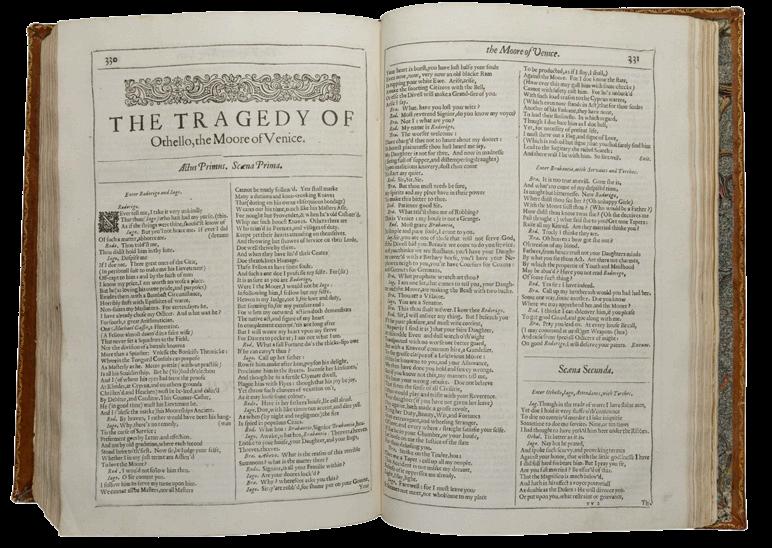
Since Seeing Race Before Race opened to the public, visitors have been drawn to the case featuring William Shakespeare’s Othello and its afterlives. Othello is one of the best-known representations of Blackness in early English theater. The play has long prompted debates about how—and if—Blackness should be performed on stage. As the books we have chosen to accompany the Second Folio edition of Othello suggest, debates about the nature of Othello’s Blackness and heroism have been raging since the play was first published. Seventeenth-century literary critic Thomas Rymer rails against Othello as a sub-par tragedy because Shakespeare deigns to give “the Moor” a name, unlike the Italian source-text, let alone cast him as a tragic hero. Meanwhile, an early eighteenth-century French translation of the play deliberately lightens Othello’s Black skin to avoid offending women in the audience.
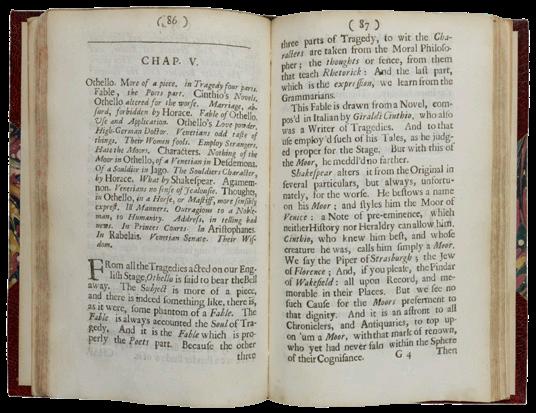
Othello has inspired powerful responses from Black artists, like Keith Hamilton Cobb, whose own play American Moor talks back forcefully both to Shakespeare’s work and a theater industry that does not seem to love its BIPOC practitioners back. Cobb has graciously lent us clips from his show to play in the gallery. “It is the greatest honor to have the opportunity to showcase American Moor in the gallery alongside so many canonical materials,” says co-curator Rebecca L. Fall. “Cobb’s play should be required viewing for all Shakepeareans and Bardolators. In achingly beautiful language, it tells the story of a Black actor auditioning for the title role in Othello while demanding to be seen and understood by the white director and the audience alike.” Throughout the exhibition we’ve included items that show moments of resistance, and with Cobb’s performance we also hear a voice of resistance.


One of the challenges in curating Seeing Race Before Race was summarizing the complex history of race and race-making for a general audience, especially when the stakes are so high and we can only tell a fraction of the story. Although working on this exhibition has been challenging at times, being able to learn from and work alongside the curatorial team, as well as across several departments within the Newberry, has been an invaluable experience. At the time of writing this, the exhibition has only been open to the public for one week and we have already received an overwhelmingly positive response from visitors, staff, and fellow academics. This affirms the importance of creating opportunities for people to think about and to discuss difficult histories.
For so many of us, the conversations Seeing Race Before Race evokes are not abstract; they are our family histories, the stories we hear from friends and co-workers, the experiences we have every day. A reflection wall at the end of the exhibition asks visitors to consider what they have seen and learned about how race was made in the past. We provide notecards and pencils for visitors to write down and share their responses to two questions: What are your hopes for future generations? How can understanding the past help us envision a more inclusive and equitable world? My hope is that this exhibition helps us understand the powerful histories of race-making that shaped our world today so that we can create a more just future.
Yasmine Hachimi is Public Humanities Fellow at the Newberry’s Center for Renaissance Studies.
Seeing Race Before Race is generously supported by the Carl & Marilynn Thoma Foundation, the Samuel H. Kress Foundation, and Pam and Doug Walter.
The exhibition will be open through December 29, 2023.
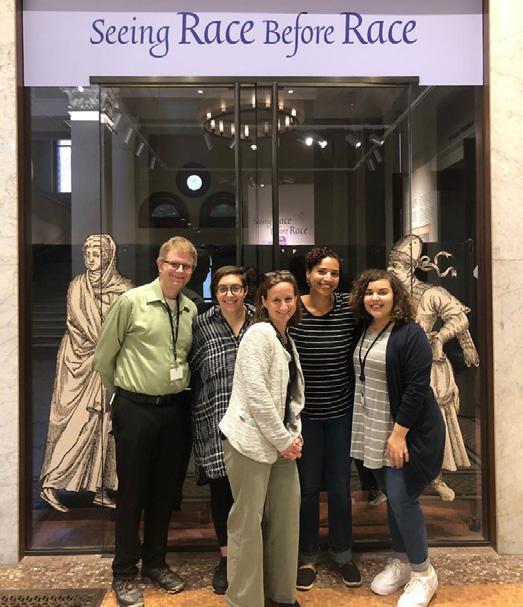
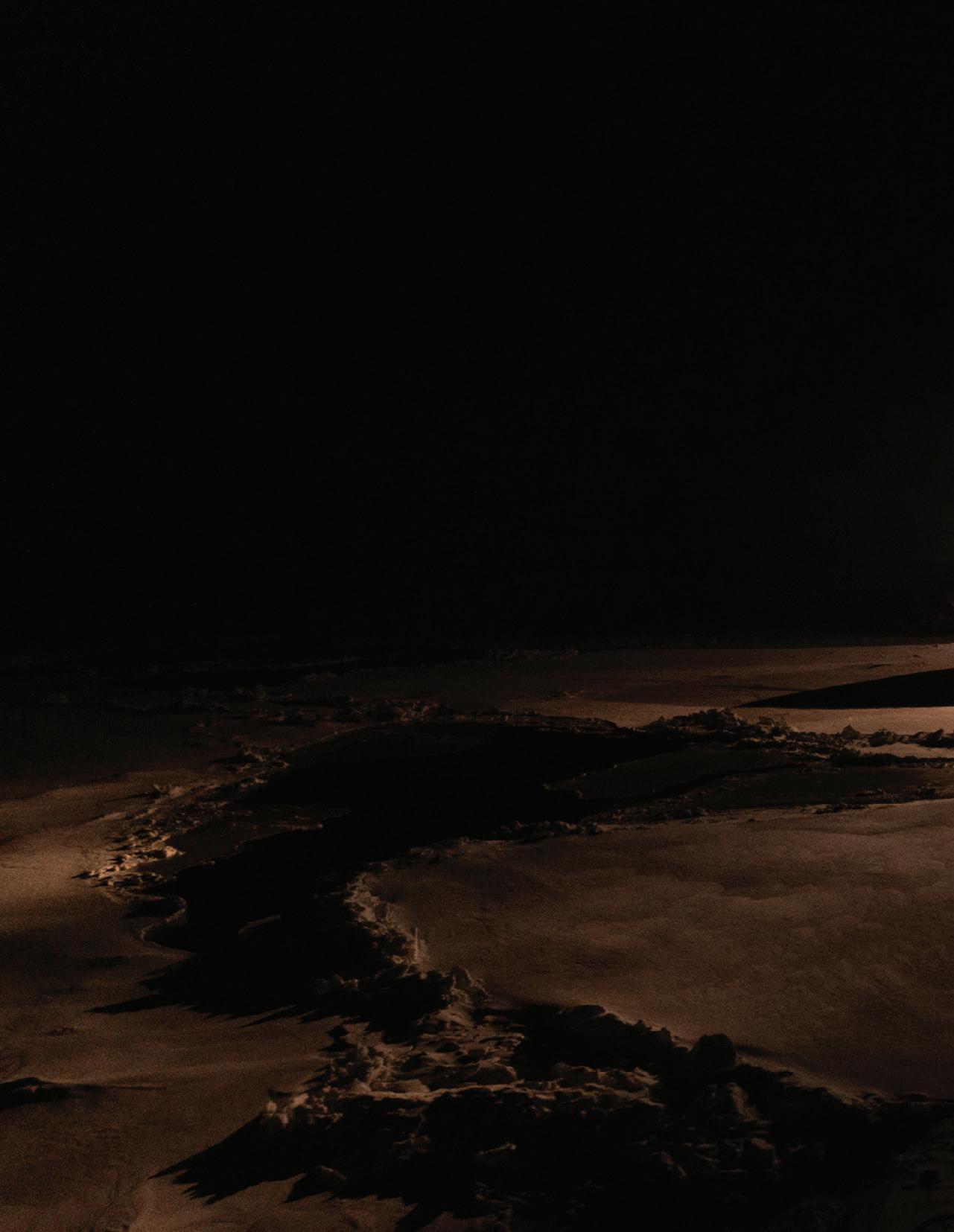
Renowned Marine Archaeologist Dives into the Newberry’s Collection

In 2019, renowned marine archaeologist Mensun Bound was Director of Exploration on an expedition to the Weddell Sea off Antarctica to locate Endurance, the lost ship of Sir Ernest Shackleton’s 1914-1917 Imperial Trans-Antarctic Expedition. That 2019 expedition failed. Undaunted, Bound returned to Antarctica three years later with the Endurance22 Expedition, and they discovered the infamous shipwreck on March 5, 2022.
Bound spoke about his adventures with the Endurance22 Expedition at a free public program this fall. During that visit, he and his wife, Joanna Yellowlees, along with Timothy Jacob, Education & Outreach Coordinator for the Endurance22 Expedition, got a special look at items from the Newberry’s Gerald F. Fitzgerald Collection of Polar Books, Maps, and Art. The Newberry acquired the collection in 1994 as a gift from Mr. Fitzgerald, a Trustee of the library and avid collector of polar material and many other subjects.
Included in the collection are a pair of reindeer skin mukluks once owned by explorer Richard Byrd. A collection of postcards depicting Arctic and Antarctic expeditions included one written by Ernest Shackleton himself. In it, he praised Plasmon biscuits—a sort of early twentieth century energy bar laden with a type of milk albumen—as an “indispensable” food in the polar regions. Among the other items was The Antarctic Book: Winter Quarters, 1907-1909, a book printed in Antarctica during an earlier Shackleton expedition.
While he was visiting the library, Bound shared stories of his adventures in a brief Q&A with the Newberry.
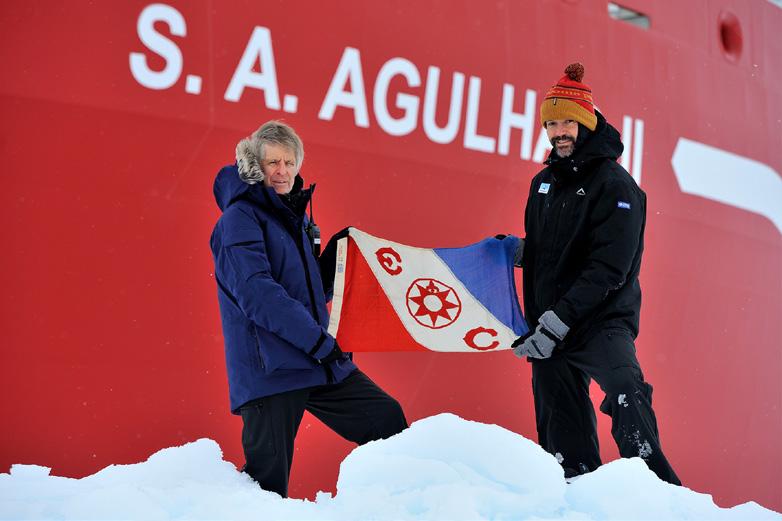
Watch the recording of “The Ship Beneath the Ice: The Discovery of Shackleton’s Endurance ” at youtube.com/user/thenewberrylibrary


Newberry Magazine (NM): You’ve been exploring shipwrecks all over the world for decades. What prompted you to seek out the Endurance after so many years?
Mensun Bound (MB): The discovery of the Endurance was two years in the making. It wasn’t actually my idea, but that of a close friend. It all began in August 2012, when he and I were meeting in a coffee bar on the Old Brompton Road, in South Kensington. At that time, I was interested in Captain Scott’s Terra Nova , the ship that took him on his fatal expedition to Antarctica in 1911. It was the centenary of his death, and the Natural History Museum was mounting a special exhibition to commemorate his life and deeds. They asked me if I could find his ship. But the very morning we were meeting in the coffee shop it was announced in the press that the Terra Nova had been found. I showed my friend the article and he said, “Well, what about the Endurance ?” That was the moment of inception. Not only was he the one who came up with the idea, but he was the single driving force behind both expeditions to find her—the first in 2019, and the second last year.
NM: Shackleton described the Endurance ’s location as “the worst portion of the worst sea in the world.” Does the Weddell Sea live up to its reputation, or are there other places you’ve experienced with more challenging conditions?
MB: Shackleton wasn’t exaggerating. The pack [ice] is out to get you and squash you like a bug. The times we got caught felt as if we were within the coils of a boa constrictor. But I have experienced worse in the Drake Passage, which sweeps under Cape Horn and the Falklands. They really are the most consistently savage seas on Earth. Back in 2014, I spent five months at sea southeast of the Falklands in an old Cold War submarine chaser that used to masquerade as a fishing boat. We were looking for Admiral Von Spee’s flagship, the Scharnhorst, that had gone down fighting in the Battle of the Falklands in 1914. On one occasion, we got hit by a freak wave (or, as the Mate described it, a “wall of water”) that whacked us over



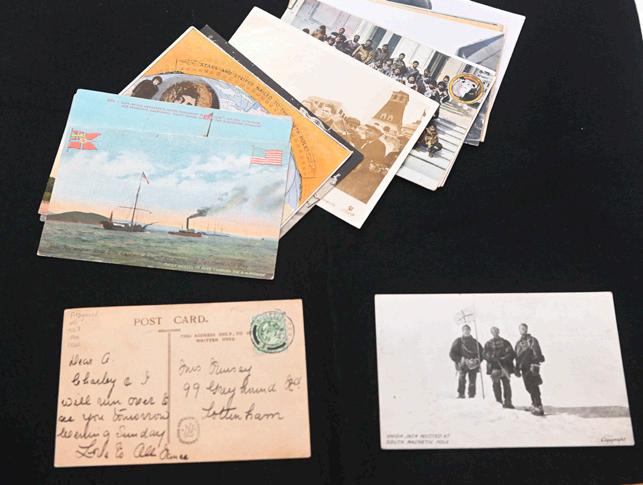

on our beam ends. You then felt the ship falling away into the hollow behind the wave. We just lay there in a pile at one side of the bridge waiting for the follow-up wave to roll us under. To this day, I remember the voice of the bosun who had been at the wheel praying in Spanish. But the second wave never came, and slowly we righted ourselves. It shouldn’t have happened but, just like Shackleton’s Endurance expedition, we all lived to tell the story.
NM: The discovery of the Endurance took place after your 2019 expedition had to be cut short due to the loss of a submersible. How much was good luck involved in 2022?
MB:: Luck, good and bad, certainly played its part. In 2019 we were unlucky. The Autonomous Underwater Vehicle (AUV) that was conducting the search was doing well. I had drawn up a search box that was 107 square nautical miles and the AUV had covered over half the area before it malfunctioned and disappeared without a trace. Now that we know the position of the Endurance, we can see that, had the AUV completed its mission, we would have found the wreck in 2019.
Last year was very different. The ice was not nearly as thick and aggressive as it had been in 2019, but we were into winter, conditions had deteriorated, and on the back deck temperatures had plummeted. The Captain had told me that neither man nor ship could take much more of it. Our backs were against the wall. And then we just got lucky. At the moment when we most needed it, we had two days of brilliant weather, and it was during that window that we discovered the wreck. But it was very tight. In fact, after we found the wreck, we only had time for two dives on her. The first to secure the data and the second was the archaeological inspection dive—the highlight of my life as an archaeologist. And that was that. The weather came back with a vengeance, and we had to get out of there post-haste.
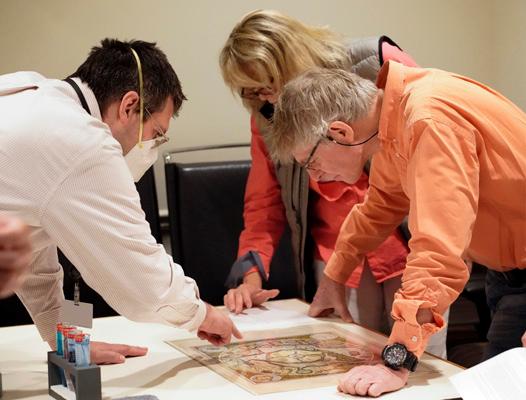

By Kara Johnson
Ayoung African American man in a Navy uniform stands at attention. He looks straight at the camera, his face stoic, his eyes penetrating. A posed salute and the elaborate staged backdrop suggest he stands in a photography studio. A horizontal crease of the blackand-white photo not only reminds the viewer of the materiality of this photograph, which has miraculously survived decades of wear and tear, but also suggests that it was folded in half and held close for safekeeping by a loved one—perhaps in uncertain times of the sailor’s whereabouts or wellbeing. One can imagine a loved one stashing this photograph in a pocket, wallet, diary, or purse as a memento of one American—of many—who participated in the war effort.
This is a 1942 photograph of fifteen-year-old Leonard Ferguson. With his mother Idalia Spivey Gould’s permission, he enlisted in the Coast Guard. His enlistment paperwork reflects his age as seventeen, the minimum age requirement to enlist with parental consent. Ferguson’s daughter, Patricia Olsson-Prescott, shared with the Newberry recently, “He was begging to go in and serve.” His mother gave permission for him to join the Coast Guard because it seemed the safest option. She did not want him to go into a branch that would be in direct combat, and in the effort to protect him she guided this decision. Ferguson’s enlistment brought his high school career, at DuSable High School in Chicago’s Bronzeville neighborhood, to an abrupt and early end. Despite Gould’s hope for an uneventful enlistment, Ferguson was at the center of action during the Second World War, including the D-Day invasion at Normandy on June 6, 1944.
It is no surprise that this photograph elicited comments of disbelief from the participants of the Newberry CPScholars Professional Development seminar for Chicago Public School (CPS) teachers, Teaching Black History through the Archives: “He’s a baby!” “Look at that face.” “He’s fifteen?!” One can presume that these educators, representing schools all over Chicago (including

Lincoln Park High School, Prosser Career Academy, Simeon Career Academy, and Kenwood Academy) could not help but connect Ferguson, barely a “young adult” heading off to war, to their own teenaged high school students. This archival photograph brings Ferguson and his family’s wartime experiences to life in the way only a research library like the Newberry can.

The Newberry’s collection reveals the vastness of everyday materials (letters, photographs, family and institutional records) that reflect a larger historical narrative. Access to these items can assist teachers in bringing these individual stories to life, for both themselves and their students. The Newberry’s approach in creating opportunities to explore these items in-person—to experience how it feels, or even smells—encourages exploration in a way few other organizations can. In doing so, these seminars prioritize the teachers’ professional learning and growth and afford the literal time and space with which to explore history at their fingertips.
Designed and facilitated in March 2023 by Stanford University’s Dr. Michael Hines, a historian of American education, Teaching Black History through the Archives invited participants to engage directly with the Newberry’s diverse selection of archival sources focused on topics such as the Great Migration, the 1919 Race Riots, educational segregation, and the impact of the Second World War on Black communities in Chicago. This seminar explored how History and Social Studies educators might enrich Black history by utilizing local archives and mining them for the personal stories that are often buried in the sweeping historical narratives featured in K-12 textbooks. Other collection items highlighted in this workshop included Chicago Defender and Chicago Tribune coverage of the 1919 Race Riots and the recently acquired, and exceedingly rare, Negro in the City lantern slides.


The Coast Guard photo belongs to the Newberry’s newly acquired Prescott Family Papers. The collection dates all the way back to 1848, and chronicles, among others, the Baumann, Prescott, and Carrington families, which came from Switzerland, Germany, the United Kingdom, France, and several African

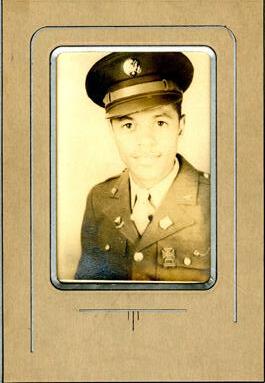
countries. They eventually settled in New Orleans and Austin, after trailblazing their way from Virginia over several generations. These families then migrated throughout the Unites States, living in Los Angeles, Boston, New Hampshire, and Hawaii before arriving in Chicago as a part of the Great Migration.
Everyday documents, including letters and photographs, vividly depict the lives of this expansive family tree. Patricia Olsson-Prescott, a living descendant of this family and Leonard Ferguson’s daughter, consulted with Dr. Hines and Dr. Kara Johnson, Director of Teacher Programs at the Newberry, to curate collection materials and provide additional biographies and anecdotes for the CPScholars Professional Development seminar. The library is currently processing and digitizing this monumental collection, thus creating worldwide access to these materials. The participants of Teaching Black History got a sneak peek at the Prescott Family Papers through high-quality facsimiles and take-home “teaching kits” they could bring back to their classrooms. It is serendipitous that these materials are featured in a CPScholars seminar, because many Prescott family members attended CPS schools, and three Prescott sisters—including Patricia Prescott’s mother, Lavinia— moved on to become educators.
With a grant from the Robert and Penelope Steiner Family Foundation, the CPScholars program launched in 2022. This idea for creating a program specifically for CPS teachers began to germinate in 2019, after the Newberry noticed a drop in attendance by local Chicago teachers at other Professional Development (PD) programs. Research into this absence revealed challenges to participant access, including a lack of PD funding at the school or district level; a nationwide substitute teacher shortage; and the residual effects of working in public education during and after the disruptive events of the COVID-19 lockdown. Not surprisingly, teachers were exhausted, in constant survival mode, and thus PD had to take a necessary backseat. Additionally, all teachers—regardless of their school district or where they teach—struggle to enliven their classroom teaching with new perspectives and ideas, particularly when preoccupied with meeting frequently changing curriculum standards and mandates.
It felt urgent for the Newberry, a Chicago-based institution, to work with the teachers of the country’s fourth-largest school district to alleviate at least some of these stressors and create a culture of collaborative inquiry focused on the Newberry’s unique historical materials. Uninterrupted time in an archive like the Newberry’s encourages engagement with primary sources and a necessary practice in the skills of historical analysis and thinking—identifying an author’s perspective; exploring the larger historical context for the source; as well as uncovering underlying messages, perspectives, and purposes for the document. Freda Brown, a librarian from Kenwood Academy, reflects on her experience with CPScholars as “deeply inspiring,” with topics that are


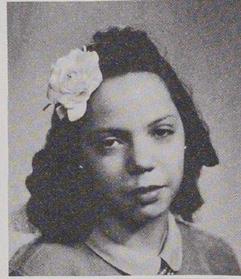

“rich, timely, and relevant to my curriculum and teaching style.” She continues, “I gained new insights into the history of education in Chicago” by examining the Newberry’s archives, including newspapers and yearbooks during Teaching Black History
One such yearbook is the Purple and White , from Englewood High School in Chicago. The Newberry’s series of Purple and White from the Second World War provides a vivid glimpse into life in an interracial high school. It also reflects the cultures of education and social life during wartime, featuring poems, tributes, and numerous references to the war that fluctuate in tone between hopeful and heartbreaking. The Purple and White also provides some provocative material for historical contextualization and analysis. “A Soldier’s Prayer,” authored by student Arthur McCoo in June 1943, features six stanzas of moody poetry, told from the perspective of a soldier at war. It concludes with the lines, “I pray, dear God, by all that’s right— / By all the stars that shine on High, / The world may soon see freedom’s light, / I pray the day of peace be nigh.” As a genre of “self-published” text resembling late twentieth century zines, school yearbooks are vivid reflections of students’ day-to-day experiences and hopes for the future. McCoo’s poem is a historical as well as literary relic of the 1940s: an attempt to document the tensions of this fearful time and the hope—a prayer—for a victorious end to the war.
At the same time Leonard Ferguson fought overseas, his future wife (and Patricia Prescott’s mother), Lavinia Prescott, attended Englewood and graduated in 1943, at the height of the Second World War. In 1947, Lavinia Prescott became an elementary teacher at Forestville Elementary, a CPS school in the Grand Boulevard neighborhood on the South Side.
The same yearbook featuring Lavinia’s graduation portrait (January 1943) includes a collage “by Jim McDonaugh” depicting
some of the graduating class as vegetables in Principal Joseph Thompson’s “victory garden,” with Assistant Principal John Kriewitz represented as a “Dude” (or farmer) tending the fields and a crossdressed teacher, “Mother Nature” Charles Burnham, overseeing the agricultural operation. This bizarre depiction lends itself to close reading, historical analysis, and provocative questions.
This strange historical artifact may raise some eyebrows, but it also raises some terrific historical questions—proving that sometimes, the weirder the primary source, the more inviting for student discussion and analysis. For instance, someone encountering this for the first time might ask, “What in the world is going on?” But, as all historians know, one does not stop there. After some additional time with the source, the questions become more complex: How does the creator use visual cues and language of the Victory Garden to reference the “home front” effort to support the war? How does this source differ in tone from the poem “A Soldier’s Prayer”? How might these sources help us understand how students of different races defined patriotism during the war?
These historical primary sources may also help students see reflections of themselves and their world in the past. There are more similarities than differences between the Purple and White and today’s high school yearbooks. As a keepsake with student contributors, the authors showcase their own high school experiences and perspectives, but with a heightened awareness to capturing the moment for future readers—including their own children and grandchildren. Like the students at the editing table for the Englewood yearbooks eighty years ago, students today also collaborate to tell their own stories; how they place themselves in larger contemporary events happening in their local communities, nation, and world; and what they choose to preserve as important memories of their school experience in these keepsake texts.
“Archival materials like these can serve as a point of entry for wider conversations about the Black experience. They provide a starting point for students and teachers to tackle big themes like migration, racism, economic opportunity, and citizenship.” — Dr. Michael Hines
A session on teaching Black history necessarily grapples with the role of race, both in war and “at home.” The Second World War era is one of the most divisive times in American history concerning race, and Leonard Ferguson is a way into that conversation, for both teachers and students. What was it like for men and women of color, like Ferguson, whose wartime patriotism was undoubtably complex, fighting the war against fascism alongside a war against racism at home? Whose additional stories can we mine in the archives for the African American wartime experience? The Prescott Papers, which are artifacts of both wartime and interracial Chicago-based schools of the time, invite a textured, nuanced story about war and education, centered on stories from everyday life. This encourages learners of all kinds to connect these historical themes to real people and lived experiences that help them resonate beyond the histories found in traditional textbooks.

With these opportunities to practice “doing history,” it becomes more second nature to actively search out these rich stories in the archives. Dr. Hines reflects on the opportunity to work with the Prescott Papers, and other Newberry collections, in Teaching Black History: “Archival materials like these can serve as a point of entry for wider conversations about the Black experience. They provide a starting point for students and teachers to tackle big themes like migration, racism, economic opportunity, and citizenship. It has been awesome to see how educators have responded to the materials thus far.” Other teacher participants commented on the seminar’s “effective discussion and strong resources” which could be brought back to their classrooms; the ample time to conduct research in the Newberry’s collection; and the opportunity to discuss classroom application.
Teaching Black History is just the beginning of the Newberry’s collaborations with Chicago Public Schools. Upcoming 2023-24 CPScholars seminars will feature such insightful and relevant topics as Media Literacy in Chicago Public Schools, Primary Sources for Native History, and Managing Teacher Wellness in Times of Crisis. Several seminars will feature interactive collection workshops in the Newberry’s reading rooms. Additionally, Dr. Hines is currently at work on digital education resources based on the Teaching Black History seminar, in collaboration with historian Dr. Tikia Hamilton (Loyola University Chicago) and Freda Brown, the 2023-24
Chicago Chapter, Daughters of the American Revolution Teacher Fellow. These digital modules, which will go live on the Newberry’s Digital Collections for the Classroom website in 2024, will focus on Chicago and the Great Migration, using the Negro in Chicago lantern slides as a gateway into examining these topics.
Social studies and history teaching is most effective when an educator has an archival experience. The Newberry’s collections enable us to do this for, and with, teachers. These programs reflect the Newberry’s commitment to helping teachers develop their skills—and inviting them to have some fun in the process. Patricia Prescott describes how her family’s “experiences have gone full circle” in these teacher programs by “passing on living history for the future, from the Newberry archives to CPS teachers and educators, who will pass their stories on.” These experiences also show the Newberry’s mission in practice: to inspire research and learning in the humanities to diverse audiences. One participant put it simply: “I appreciated seeing the archives today. That was special.” Fewer statements can capture more concisely what the Newberry Library is all about.
Kara Johnson is Director of Teacher Programs at the Newberry.
By Haku
Toya Wolfe is the recipient of the 2023 Pattis Family Foundation Chicago Book Award at the Newberry Library for her debut novel Last Summer on State Street, which tells the riveting and heartbreaking story of adolescent girls growing up on Chicago’s South Side in the 1990s. Toya recently sat down with D. Bradford Hunt, Professor and Chair of the History Department at Loyola University Chicago and author of Blueprint for Disaster: The Unraveling of Chicago Public Housing. They discussed Toya’s work as a writer and how her novel reflects her own childhood living in the Robert Taylor Homes, a public housing development that stood in the Bronzeville neighborhood of Chicago from 1962 to 2007.
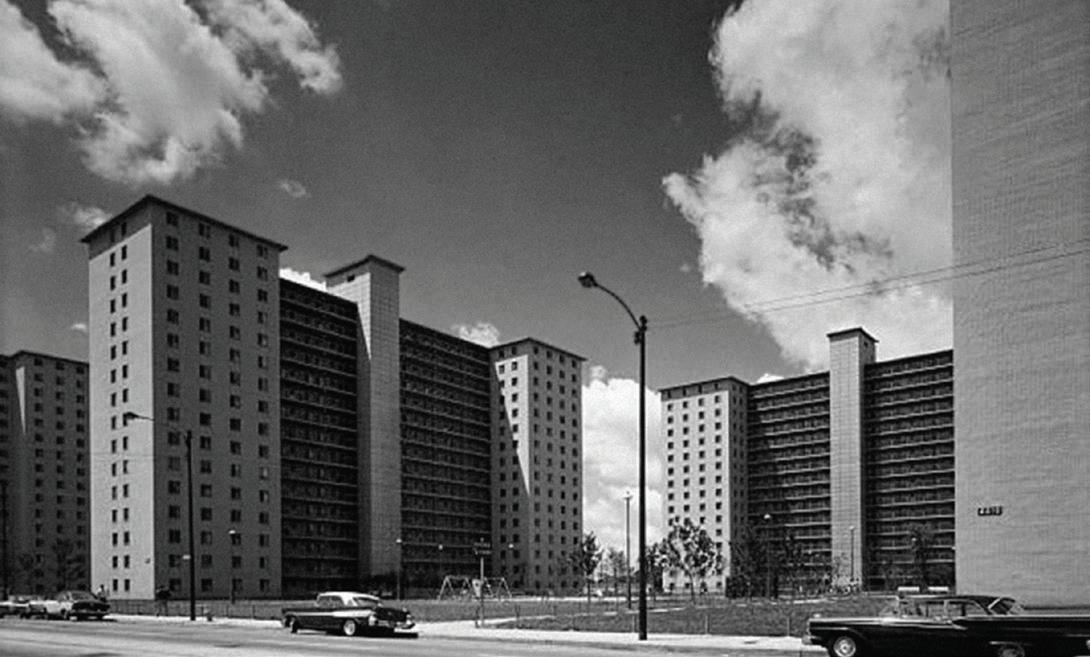


D. Hunt (DH): I’m very interested in how you came to think of yourself as a writer, a novelist, a short story writer. Can you walk us through that arc?
Toya Wolfe (TW): When I was an undergrad, I studied at Columbia [College] as a fiction writing major. But I feel like I latched on to the identity of “writer” very early, even in childhood. And for me, it wasn’t about who had published you or blessed you with the title. I felt like I was writing, and that made me a writer. That is very bold because I would go on to realize that people really struggle with psychologically calling themselves a writer. For me, I’m writing things and whether they’re good or not, I’m putting in the time to put words down that did not exist before. And so, I think even going into formal education, I didn’t struggle with that title. And I think it helped me later when I started publishing things because once you publish a novel, then you must wrestle with this identity, and you could get tangled up in reviews and book sales and things like that. But if you already have a grasp on your identity as a writer who writes because you have talent and because you have something to say and because you enjoy it, then you don’t get tangled up in the politics.
DH: Who are some of your heroes as novelists? Let’s start with Gwendolyn Brooks. How did she influence your thinking?
TW: She was one of the first Black women writers from Chicago that I was introduced to. She’s writing about my neighborhood, but decades before. There’s this paper trail of a conversation that we’re both having about the same neighborhood. And that’s so fascinating to me. If someone had ever accused me of being a history buff, I would have denied it. But I’m working on my second book and already I’m steeping myself in Chicago history again. So, I think reading Gwendolyn Brooks, to me, feels like taking a trip back to her Bronzeville.
“The places in this book, they’re all ripped from my life. I created these characters, I put together this plot, but these places are very real.”
—Toya Wolfe
She was the first, and then I have my two Toni’s—Toni Morrison and Toni Cade Bambara, who unfortunately is a little bit lesser known to a lot of people. Toni Morrison was Toni Cade Bambara’s editor at Random House. When I was in undergrad, I read her short story called The Lesson , and it was the first time I actually heard the voices of little Black kids who spoke the way that kids spoke, the way we spoke growing up. And it gave me permission to play around with dialect and to actually capture voices the way you hear them, and to not be ashamed to put them down because they’re not eloquent English.
So, I’ve got the two Tonis, and, of course, Zora Neale Hurston. It’s a name I want to keep in the conversation because she’s been gone for a long, long time. But I think she’s also someone who tried to capture a neighborhood and the voices and the culture and how community interacts. She really laid that down in her books in this beautiful, authentic way. There were these women who were taking their slice of society and writing about it. And they kind of inspired me to go and do what they did.

DH: In Last Summer on State Street you are playing with how the characters process the events that have happened to them. Am I right in thinking that’s something that you centered on as you were writing this novel?
TW: Yeah, I think eventually I figured out that this was a book about characters who hadn’t dealt with the things that happened to them. I’m always very interested in works where characters are wrestling with their feelings or what they know or how much they’re going to share their feelings. And so, it doesn’t surprise me that my first book has these characters who are wrestling. Memory is very tricky, and it can’t always be trusted. It was fun to give this character all of these events that she would have to recall. And then she’s wrestling with how she processed them as a child, but also with what she knows now as an adult. And then she must wrestle with what she’s going to do with all these feelings because she has some big decisions to make regarding redemption and forgiveness.
Memory is super important in this book. And it’s not just memory of the events that happened that summer. You have characters like Mama Pearl who talk about the things she remembered as she becomes this oral storyteller. And then you have characters who don’t talk a lot about their past and their history. They could, but they choose to hold it close to the chest or they choose to reveal their memories in more secret ways. There’s a lot of reflection and characters thinking about what happened and deciding how they will share that.
DH: This idea of having to unburden oneself. It struck me as a theme, but I also wondered whether this novel was a way for you personally to unburden your memories of your own childhood and the Robert Taylor Homes.
TW: I actually think these characters had it much worse than I did. I think for me, the most traumatic part was revisiting these buildings. When I think about my childhood in the Robert Taylor Homes, I see it as less eventful than what these girls encounter. And this is the power of imagination and playing around with worst-case scenarios. There’s a lot of truth in this book. Those police sweeps were very, very real. I definitely encountered things like that. You could be hanging out with your friends and then you hear gunshots and whatever you were doing is not important anymore. You need to fall on the ground. I just think revisiting that lifestyle was pretty heavy. And as much as I would love to tell people that writing this book was such a catharsis for me, I actually think it was harder to throw myself back into this world as an adult. Because sometimes when you live in a situation, it’s troubling and it’s traumatic, but it is your existence. But imagine if you are a few decades removed from that, you’ve been living a life that is nothing like that world. And now I spent all day, every day in this story world that is very—honestly, the places in this book, they’re all ripped from my life. I created these characters, I put together this plot, but these places are very real. And so, I cannot say that writing this book gave me some wonderful release. I think it’s a little bit of the opposite. There’s a little bit of shock that happened after it was done. But I think it’s totally worth it. It’s worth it because there were so many people who wrote to me or came up to me and said, “I had no idea that people had to live this way. I had no idea. These buildings that I drove past on the Dan Ryan, this is what was happening inside.”
I had a really wonderful childhood. I grew up in a terrible place, but I just think my mother was so intentional about making sure that my siblings and I had joy in our lives and that we knew we could do anything we wanted when you grow up. My apartment was such an insulated, wonderful place. As much as you can have joy and peace in a neighborhood like that.
DH: Did you actually go back to the Robert Taylor Homes site now that it’s gone?
TW: I did because I worked on this manuscript for about 15 years. And in the time that I was polishing these pages, I probably went back two or three times. Sometimes it was an accident. I was going somewhere and the GPS took me straight down State Street, and I was like, “Whoa, okay.” And then after I wrote one of the final chapters, I intentionally went just to re-acclimate myself with what the space looked like now. And I was just really struck by what it looked like. Everything seemed so much bigger when I was younger. And also, the tragedy of how many humans lived compacted into that half block that’s across the street from DuSable High School. And so, I think going back to this whole idea of the writing process, if this was my story, if this was actually what happened to me, then maybe it would’ve been helpful. But even going back to visit was really shocking. I lived in these conditions as a child, lived there until I was 18 and went away to college and a dorm. How in the world did I live like this?
DH: When I was doing my book on the history of the Chicago Housing Authority, I got to tour a Robert Taylor Homes building. It had just been renovated in 1996, and they thought maybe they were going to save it, and ten years later they tore it down. Most white Chicagoans never set foot in the Robert Taylor Homes. And I think one of the brilliant elements of this book is your ability to capture the building as a character with the stairwells, the elevator. Is that a fair statement?
TW: I’m not surprised that you feel that way because in my educational upbringing there was so much emphasis on place. And I’m also a Chicagoan. We love our skyscrapers and our special places. I teach Master’s creative writing students, and I’m always talking about building a world, and that’s language for science fiction writers usually. But it’s because people sometimes forget to lean into the places where their characters are running around. It actually helps you build character. So, it’s the beautiful effect of a person getting to know a different place they’ve maybe never traveled to, but they also get to see how their characters move around in this space and how you could let a place sort of antagonize the character or give them a safe space to be. I really enjoy building these homes for characters to run around in and do the crazy things that they’re up to. So, this building was a no-brainer because I grew up there and I knew about all the crevices, the way that different groups of people use the space in certain ways.
DH: And that is one of the several real strengths of this book. You paint such an incredible portrait of housing, the Robert Taylor Homes at its nadir, at its worst. This book is about loss, including the loss of one’s home. It’s about pain. How do you get your characters to deal with loss?
TW: Writing this book was about letting 12-year-olds have feelings, putting them on display. And I think one of the earliest seeds of this story—I was working at a community center that was across the street from the Robert Taylor Homes. My sister was in high school, and my mother had probably just received a letter stating that the Plan for Transformation, all this relocation business, was happening. I just thought about these kids and how at 12 years old they’re going to have to deal with leaving their friends, their school, their neighborhood. And when you’re 12, that’s really all you care about. Think about The Wonder Years and how you’ve got these kids running around the sidewalk in the suburbs. And imagine if someone said to them, “We’re bulldozing this entire neighborhood of homes, and we’ll figure out later where you’re going to go. Also, you probably won’t see your friends anymore. And you’re going to have to leave your school where your beloved teachers are.” And I just kind of ran with that. I just think that we don’t oftentimes think of young people as humans. They’re kids, and kids aren’t fully grown humans. I just really wanted to show these kids falling apart and choosing to get back up or not choosing to get back up. Or not having the opportunity to get back up. It’s a book about loss, and it’s also a book about the choices people make and how they’re going to deal with loss. Or not deal with that at all.
DH: You’re describing life in the Robert Taylor Homes in the late 1990s. It’s pretty grim on some levels. Were you ever concerned about telling a version of a poor Black community? Did you ever feel that you were going to perpetuate stereotypes?
TW: I think as a writer, you cannot fall into those ideas. You can’t. I’ve also learned censorship is the antagonist of creativity. And I think when you write about your people and you love them, it’ll come through. When I sit down to write, I’m just really trying to pull out what’s inside. And I spend a lot of time revising. I have very smart writers who read my stuff, and we talk about it. I really want to make sure that I’m putting things out into the world that are true to what I’m seeing. I love my people. And I think even though I write about alcoholics and crack addicts, there are all these different kinds
of people. I want to be honest about how the way we interact with them in our neighborhood is that they’re not just these things. For some of us, we remember that they are whole beings who have fallen into disrepair, and there’s always this hope that you’re going to get these people back. There are all kinds of characters in this novel, and I want to focus on their humanity.
DH: I noticed you mentioned the Newberry Library in your acknowledgements. What was the connection between the Newberry and this book?
TW: There were a few really great institutions that I utilized for research. I do research at the very, very end because research is candy to writers, we could just fall down a rabbit hole sucking up information and not actually writing anything. And so, at the very end, I always go and do research just to make sure that my memory is correct. I knew the Newberry would have some really cool things about Bronzeville and high-rises, and I was correct. I went in and looked through the collections and it just layered things for me.
DH: You won The Pattis Family Foundation Chicago Book Award for Last Summer on State Street. What did you do to celebrate?
TW: Well, I spent the weekend with my mom and my best friend. I invited a few people who were just so instrumental in the manuscript coming together, so it felt like a little reunion. We spent the weekend in the city, we stayed in a hotel. I got to do some of the fun Chicago things I love to do.
This is a big deal. When someone says they are trying to choose the best book written about Chicago this year, and you won, that’s such a huge honor. Do you know how many talented writers there are in Chicago? Yes, there’s this huge monetary piece of it. But I just think about the honor of someone saying to you, “You really did our city. You wrote our city. Even though you’re writing about these very tough things, we recognized ourselves in some part of what you wrote, and we’re proud of you as a Chicagoan.”

The Newberry recognized author Toya Wolfe as the 2023 winner of The Pattis Family Foundation Chicago Book Award on Saturday, July 15. Wolfe wrote Last Summer on State Street, a novel the New York Times Book Review called “tragic, hopeful, brimming with love.” The award honors books that transform public understanding of Chicago, its history, and its people. Last Summer on State Street features the story of four preteen girls as they navigate their friendship with the Robert Taylor Homes as the backdrop. “Applause to [Toya] for a wonderful book which does exactly what we hoped this award would do,” said Lisa Pattis of The Pattis Family Foundation. “It immerses us in Chicago’s story, and we emerge with a better understanding of our city.”
The award presentation took place as part of the Newberry’s Chicago Storytelling in Bughouse Square 2023: Chicago Forward, an afternoon of storytelling, music, and entertainment. The event was emceed by legendary journalist Rick Kogan and featured stories by Shermann Dilla Thomas, Chad the Bird, and others. Guests were also treated to a rousing double Dutch performance by Chicago’s Jumping Juniors.



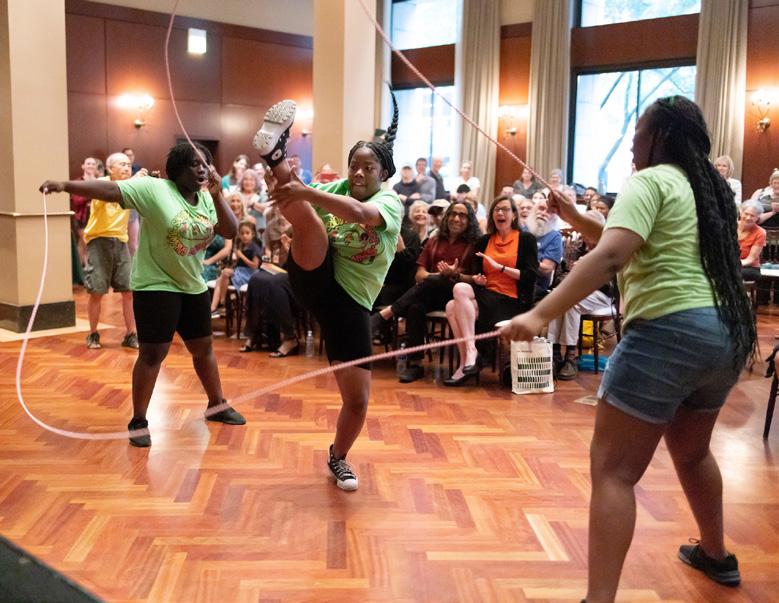
Select items from the Newberry’s holdings provided a conversation starter and relationship-building opportunity at the annual Gathering of Potawatomi Nations in Michigan this past summer. Kabl Wilkerson, a research fellow in the Newberry’s D’Arcy McNickle Center for American Indian and Indigenous Studies, joined Dr. Blaire Morseau, Assistant Professor in the Department of Religious Studies at Michigan State University, to showcase collection items and interact with member of the Potawatomi Nation, encompassing 11 bands across the United States and Canada. The gathering included a Potawatomi language conference, crafting classes, ceremonies, and opportunities for connection among nation members.


We kicked off our fall programming series—and celebrated the 400th anniversary of Shakespeare’s First Folio—on September 5, 2023, with an evening of theater anecdotes and printing history. Greg Doran, esteemed director and former Artistic Director of the Royal Shakespeare Company, stopped by Chicago on a personal worldwide expedition to see copies of the First Folio.

After spending time with the Newberry’s Folio, Doran was joined in conversation by Barbara Gaines, founder of Chicago Shakespeare Theater. Program attendees were also treated to a brief printing history of the First Folio by our own Jill Gage, Custodian of the John M. Wing Foundation on the History of Printing and Bibliographer for British Literature and History.
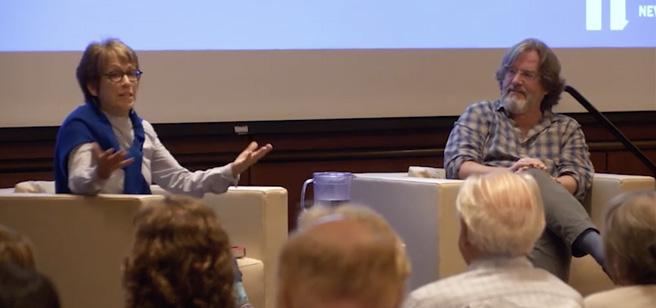
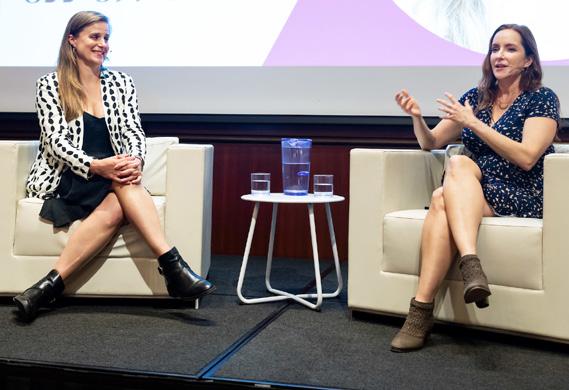
New York Times bestselling authors Lauren Groff (The Vaster Wilds, Fates and Furies, Matrix) and Rebecca Makkai (I Have Some Questions for You, The Great Believers) visited the Newberry on October 4, 2023, for the inaugural program in our new “Writers on Writing” series. The two entertained attendees with tales of their writing processes (Groff writes all drafts of her novels in longhand; Makkai drafts in her head), the importance of research to the writing process, and the power “writing into your urgency.”
“Writers on Writing” is designed to give a glimpse behind the creative curtain with some of today’s most celebrated and accomplished writers. Join us on March 21, 2024, to hear from Hanif Abdurraqib and Eve L. Ewing. Jericho Brown and Robyn Schiff will join us on May 9, 2024.
“Writers on Writing” is presented in partnership with StoryStudio Chicago and is generously supported by Shanti Nagarkatti and Sue and Melvin Gray.
What is the first skyscraper? This question and others were explored on October 12, 2023, when Lee Bey, architecture critic for the Chicago Sun-Times, interviewed Thomas Leslie, FAIA, professor in the School of Architecture at the University of Illinois at Urbana-Champaign. The talk centered on Leslie’s new book, Chicago Skyscrapers, 1934-1986: How Technology, Politics, Finance, and Race Reshaped the City. The two discussed the growth of Chicago’s downtown as both a commercial and residential hub under Richard J. Daley, the relationship between public housing and high-rises, and the technological advances in architecture that led to the upward expansion of the Chicago skyline. The talk closed with Leslie making the argument that the first skyscraper is Chicago’s own Fisher Building, located at 343 South Dearborn Street.
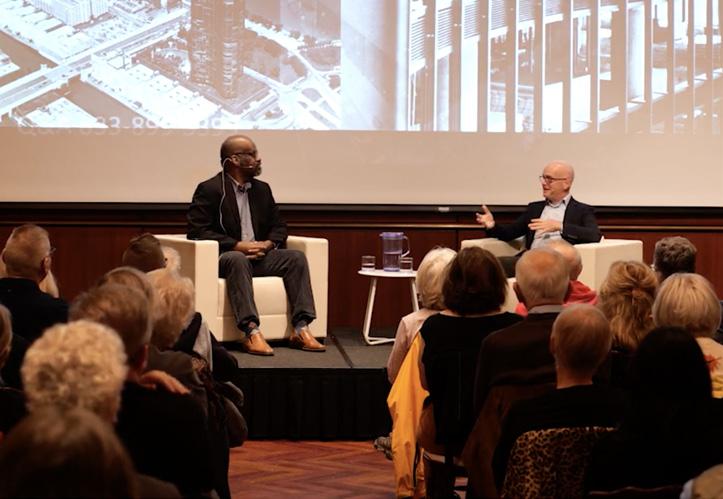
Public programs at the Newberry are always free and open to all. Most programs are livestreamed, making it easier than ever to attend a Newberry program from around the country or across the globe. Recordings of our livestreamed programs are available on YouTube at youtube.com/user/thenewberrylibrary.
View a list of all upcoming programs, classes, tours, and much more at newberry.org/calendar.


Dear Newberry Friends and Supporters,
Leading this institution is a great privilege and doing so in our roles as Interim President and Chair of the Board of Trustees has been truly rewarding. Our reverence for this library—its history, staff, collection, and the generosity of its mission—has only grown in recent months. It has also been a pleasure to get to know many of you at our programs and in our reading rooms. The community of loyal “Newberrians” is extraordinary, and we are lucky to have so many friends who care deeply about the library and its well-being.
We are thrilled to be placing the future of the Newberry in the hands of a new President and Librarian this fall. Astrida Orle Tantillo will step into the President’s Office on December 1 (see the announcement on page 4 for more details). Astrida comes to the library with a deep commitment to the humanities as a scholar and an educator, having led the University of Illinois Chicago’s College of Liberal Arts and Sciences from 2012 to 2022. She is a proven leader and fundraiser, with a wealth of experience managing a complex organization. We are confident that she is well-positioned to lead the next chapter in the Newberry’s long history.
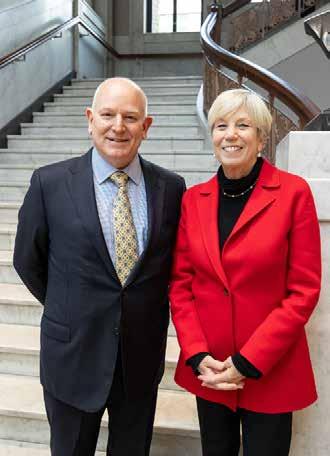
Astrida will take the reins of a strong, vibrant institution, one firmly dedicated to its mission of encouraging research, learning, and teaching in the humanities. In 2022, we approved a five-year strategic plan that focuses on meeting the needs of current and expanded audiences, and we have already made great strides towards our goals. Perhaps most notably, we established a new Division of Public Engagement in 2023, bringing together the departments of Exhibitions, Public Programs and Adult Education, and Communications and Marketing. This restructuring puts a focus on refining our offerings for the public, building awareness of the library in order to attract new audiences, and pursuing new programming initiatives and strategic partnerships.
Our renewed focus on public outreach has not come at the expense of service to readers and scholars, which remains at the core of the Newberry’s mission. For the first time since the onset of the pandemic, the Newberry’s reading rooms were open without interruption in 2022-23. We were happy to see our patrons’ ongoing
enthusiasm for using our collection in person. We welcomed a full class of more than 50 fellows to the library, as well as eager and energetic undergraduate classes from four Chicago-area universities and Colorado College. Our reading rooms, carrels, and seminar rooms are buzzing with conversation and debate once again.
There is no doubt that 2022-23 was a year of transition for the library, another in a series of challenging years we’ve encountered since 2020. Yet the Newberry continues to thrive as an active and interactive center for the exchange of ideas. What has sustained the Newberry during these moments of transition and challenge? Our immediate answer is the excellence and dedication of the Newberry’s staff, and the enthusiasm they exhibit every day working together and serving those who use and love the Newberry. There is a level of commitment—to the collection, to the mission, to each other—that is on display in every corner of the Newberry.
In the following pages you will read more about the impressive work happening across the organization. This work can only happen because of the support of friends like you. Thank you for playing an important role in keeping the Newberry a vibrant home for the exploration of the humanities.
Sincerely,

Robert A. Holland, Chair, Board of Trustees

Gail Kern Paster, Interim President and Librarian
In March, the Newberry formed the new division of Public Engagement with the goals of improving understanding of our audiences; raising awareness of the library; and continuing to offer the programs, classes, and exhibitions that attract thousands of people to the library each year.
Visitors enjoyed five exhibitions in 2022-23 that brilliantly showcased the breadth and relevance of Newberry collections. A Show of Hands: Handwriting in the Age of Print and Pop-Up Books through the Ages delighted and educated attendees in our main exhibition space. Smaller shows— Handmaidens for Travelers: The Pullman Company Maids ; Celebrating 50 Years of Newberry Research Centers; Surviving the Long Wars: Residues and Rebellions ; and Wheels were no less compelling for their size. Surviving the Long Wars also highlighted the importance of collaboration, in this case with the Veteran Art Triennial. Overall attendance to exhibitions in 2022-23 exceeded 34,000 visitors—and all expectations.
The Newberry’s long tradition of offering relevant, engaging, and entertaining programs and classes continued in 2022-23. Adult Education offered a well-attended hands-on workshop related to Pop-Up Books through the Ages , providing learners a creative connection to the popular exhibition. We also piloted a new premium Master Class series. The inaugural class, “Americans and the Holocaust,” was led by former Newberry President and Librarian Daniel Greene.
In 2022-23, Newberry public programs were routinely livestreamed and recorded, with most recordings posted on the library’s YouTube channel afterward. This allowed us to expand our audience well beyond the walls of the library. A refreshed version of the Bughouse Square Debates program featured a series of storytellers expounding on the pleasures and perils of living in Chicago and culminated in the presentation of the inaugural Pattis Family Foundation Chicago Book Award to Dawn Turner for Three


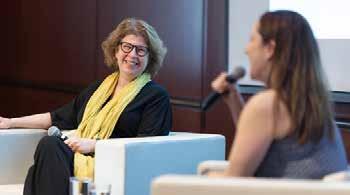
Girls from Bronzeville. We also launched a new “Writers on Writing” series in partnership with StoryStudio Chicago, with local novelist Rebecca Makkai’s compelling conversation with New York-based and New York Times bestselling author Meg Wolitzer.
A major step in helping audiences navigate all the Newberry has to offer was the rollout of a newly designed website in October 2022. Increased activity on social media and mentions across traditional media outlets such as Crain’s Chicago Business , Chicago Sun-Times , WTTW, and WGN TV, showcase how we are working hard to tell the Newberry story across Chicagoland and beyond.
We are energized by the work done in 2022-23 and the alignment of these important functions of the Newberry under the new umbrella of Public Engagement. We look forward to reaching new constituents and enriching minds through diverse and innovative programs, exhibitions, and classes in the year ahead.


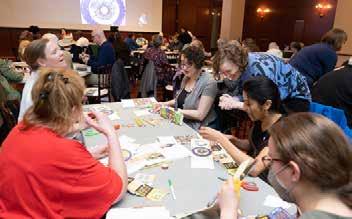

84,155 people followed the Newberry across all social media channels.
1,670 learners (73% virtually and 27% in-person) participated in 103 Adult Education classes.
7,418 people attended 32 programs (10 in-person, 3 virtual, and 19 hybrid).
34,221 visitors explored 5 exhibitions.

The Newberry is an intellectual home for a broad range of users. Teachers, undergraduate students, research fellows, and other academics rely on the library as a place for deep exploration into our collections, insightful conversation, and meaningful collaboration.
We welcomed 12 long-term fellows in 2022-23. They spent an academic year doing in-depth research at the Newberry and arrived from a range of disciplines, including history, literature, art history, musicology, Africana studies, and human ecology. We also hosted 38 short-term fellows. In residence for one month, these scholars worked intensively in the collection to further their projects, which ranged from a study of the Black Mediterranean in the early modern world to a material history of photography and minerals in the nineteenth century.
We were delighted to host “Inventing Mexico: Maps, Manuscripts, and Materiality, 1521-1921,” for the 2023 Newberry Library Undergraduate Seminar. This course brought together 20 undergraduates across four local institutions, affording them the opportunity to dig deep into the Newberry’s archives. The students completed an extensive research paper at the end of the course and presented their work to the Newberry’s staff and scholarly community. We also hosted an undergraduate thesis class from Colorado College, which brought nine seniors to Chicago for research on their individual projects.
Staff continually assess how to best serve teachers, and 2022-23 saw the official launch of our CPScholars program, which brings Chicago Public School educators to the Newberry to grow as classroom professionals and ambassadors of knowledge. Four seminars were offered in this inaugural year, attracting nearly 50

educators to cover such topics as “Native History in the Classroom” and “Teaching Black History through the Archives.” A notable feature of CPScholars programs is the development of take-home facsimile kits, which allow participants to continue their learning through high-quality reproductions of collection materials featured in the seminars.
Our three research centers convened diverse communities of scholars to advance and disseminate their research. Each center engages both scholars and community members in conversation about important and timely research topics. The Center for Renaissance Studies connected with the field of premodern studies through symposia, conferences, workshops, and courses. The year culminated with the final preparations for the fall 2023 exhibition, Seeing Race Before Race . Staff in the D’Arcy McNickle Center for American Indian and Indigenous Studies held a two-day strategic planning event in November that brought together five community partners, six Indigenous Information Science experts, and ten Newberry staff members from across the library to make a three-year plan for Indigenous initiatives at the library. 2022-23 was a time of transition for the Hermon Dunlap Smith Center for the History of Cartography, with the retirement of long-time director Jim Akerman and the arrival of Dave Weimer as the new director.
Our collections hold countless stories, and our community of scholars is well poised to help us continue a long legacy of discovery at the Newberry. We are excited by what will learn next thanks to the expertise of staff and the insatiable curiosity of our fellows, teachers, and students.

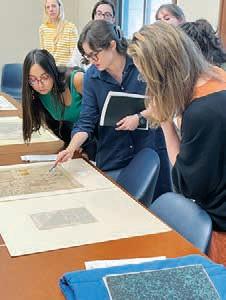


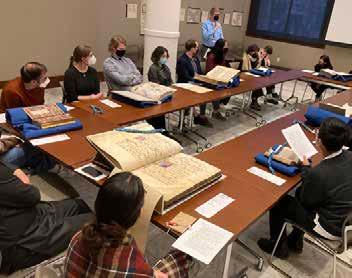
50 fellows (12 long-term and 38 short-term) delved into the Newberry’s collections to further their research.
959 participants attended 48 scholarly seminars on topics as diverse as Latino/a studies, premodern studies, and European art.
95,700 unique visitors utilized the Digital Collections for the Classroom site.
1,691 attendees participated in programs presented by the Center for Renaissance Studies, both online and in-person.


The Newberry’s collection chronicles both personal stories and historic moments across 600 years of human history. It also lives at the center of all we do at the library. In 2022-23, the care, growth, and use of the collection was once more a major focus for staff.
The collection, though rooted in history, continues to grow and evolve. In the course of the past year, we added more than 2,400 titles, both through gifts from individual donors and purchases by our curatorial team. Acquisitions allow us to bring new and diverse voices into the archive. This year, for example, we acquired a very rare group of images documenting the Great Migration—the migration of African Americans from the South to Chicago and other cities in the North in the early twentieth century. (See images below.)
Our reading rooms continue to be a popular destination for researchers of all levels. 2022-23 marked the first time since 2018-19 that there were no closures to the rooms due to the COVID-19 pandemic, and usage increased substantially. With a robust focus on instruction and outreach, we also saw significant increases in collection presentations to external groups, including those from local high schools and universities. We also relaunched the popular Newberry 101 and Genealogy 101 orientations that had been dormant since the pandemic.

Staff in Digital Initiatives and Services unveiled a new asset management system that went live to the public in October. This new system helped users from all 50 states and 175 countries explore and engage with our digital collections, which continue to grow by leaps and bounds. This year alone, more than 94,000 digital files of Newberry collection items were created.
We are thrilled that our collection continues to see so much use, and its care and upkeep remains a priority for the Newberry. Our conservators monitor climate (and keep an eye out for pests), repair items for safe use, create custom enclosures, and prepare items for display in our exhibition galleries. With their expert care, the collection will be accessible for countless years to come.
Whether visitors encounter the collection in the reading rooms, online, or in our exhibition galleries, staff remain committed to keeping it freely accessible to broad and diverse audiences. Our collection is your collection, and we hope you find inspiration no matter which corners of the archive you explore.


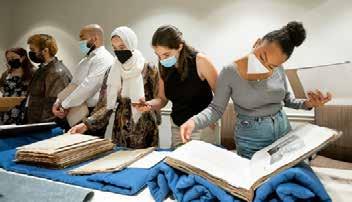

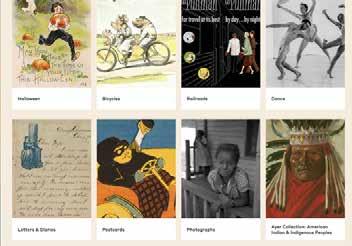

4,256 titles were cataloged, making them accessible to researchers.
1,830 protective enclosures were constructed by Conservation staff and volunteers.
2,038 gigabytes of born-digital files were acquired in six new Modern Manuscript collections.
20,418 manuscript pages were transcribed by online volunteers.
4,010 individuals registered as Newberry readers.
3,485 unique readers made 10,687 visits to reading rooms and requested 13,747 items.
3,220 participants attended virtual or in-person Instruction and Outreach activities, of which 155 were collection presentations for 2,235 attendees.
The Newberry continues to benefit from the extraordinary generosity of our community. In 2022-23, more than 2,000 donors contributed an impressive $7.6 million to the library, not including pledged future commitments. The Newberry relies on these contributions to provide the services, programs, and access to our collection upon which countless people rely. We are grateful to each and every person who supports our work.
Donors at all levels contributed more than $1.8 million to the Annual Fund, providing critical operational support. Estate gifts accounted for nearly $2 million, once more proving the impact of deferred gift commitments. We continued to focus on strategic funding priorities: public engagement and exhibitions; digital infrastructure and digitization; and Diversity, Equity, and Inclusion efforts. A total of $2.5 million was raised for these areas, including a five-year grant of $1 million from The Grainger Foundation, which supports our digital activities.
The 2023 Award Celebration, honoring filmmaker Ken Burns, was held in May, generating significant funds to support the library. More than 250 guests gathered to celebrate the Newberry, the humanities, libraries, and the power of storytelling. Donors also attended other special events throughout the year—both in-person and online—to learn more about the Newberry and engage with staff and scholars.
There are many ways to support the Newberry, and our dedicated corps of volunteers contributed more than 7,000 hours of service to the library. Volunteers proved invaluable, greeting guests, giving tours, and assisting with programs and events such as Book Fair. Their presence on the first floor helps create a welcoming and engaging environment for all who visit the library.
We are immensely thankful for all who contribute to our mission with their time and their financial gifts. More details on our financial position can be found on the following pages.

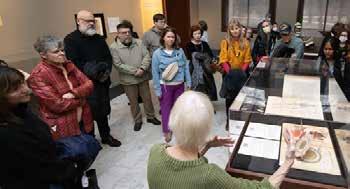

182 volunteers contributed 7,424 hours of service.
425 first-time donors supported the Annual Fund.
9 people joined the Blatchford Society, the Newberry’s planned giving donor group.
634 donors and guests attended special events and fundraisers.
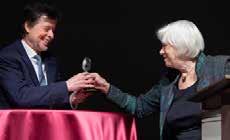

Summary of Financial Position
For the year ended June 30, 2023, and for the year ended June 30, 2022 (000s omitted).
Summary of Activities

For the year ended June 30, 2023, and for the year ended June 30, 2022 (000s omitted).
Revenues
Expenditures
4,062 996 13,665 $(14,702)
The following donors generously made gifts to the Annual Fund and are recognized as members of the President’s Fellows or Newberry Associates.
PRESIDENT’S CABINET
($25,000 AND ABOVE)
Roger and Julie Baskes
Joan and William Brodsky
Jan and Frank Cicero, Jr.
The Crown Family
Robert and Joan Feitler
Alice and Richard Godfrey
Victoria J. Herget and Robert K. Parsons
Celia and David Hilliard
Dr. Elizabeth Amy Liebman
The John D. and Catherine T. MacArthur Foundation
Cindy and Stephen Mitchell
Ms. Susan Nagarkatti
Janis W. and John K. Notz, Jr.
Dr. Gail Kern Paster
The Pattis Family Foundation
Christine and Michael Pope
Roy and Irene Rettinger Foundation
Sheli Z. Rosenberg and Burton X. Rosenberg
Mr. Joseph B. Rousseau
Mr. Rudy L. Ruggles, Jr.
Karla Scherer
Mr. David B. Smith, Jr. and Ms. Ilene T. Weinreich
Nancy and Richard Spain
Ms. Carol Warshawsky
PRESIDENT’S CIRCLE
($10,000 - $24,999)
Mr. Gregory L. Barton
Buchanan Family Foundation
Lew Collens and Nancy Sindelar
Celine Fitzgerald
Julius N. Frankel Foundation
James. J.* and Louise R. Glasser
Dr. Hanna H. Gray
John R. Halligan Charitable Fund
Helen M. Harrison Foundation
Mark and Meg Hausberg
Robert A. Holland
ITW
Professor Lawrence Lipking
Barry MacLean
Mr. Stephen A. MacLean
Professor James H. Marrow and D r. Emily Rose
Andrew and Jeanine McNally
Ken* and Jossy Nebenzahl
Jean E. Perkins and Leland E. Hutchinson
Mr. John P. Rompon and Ms. Marian E. Casey
Mrs. David Savner
Adele Simmons
Mr. and Mrs. Richard D. Siragusa
Carl W. Stern and Holly Hayes
Liz Stiffel
Yellow-crowned Foundation
Anonymous (2)
PRESIDENT’S SENIOR FELLOWS
($5,000 TO $9,999)
Karen-edis Barzman
Ann Bates Kittle
Tom and Melanie Berg
Ms. Sharon P. Cole
Nancy Raymond Corral
Dr. and Mrs. Tapas K. Das Gupta
Professors Stephen and Verna Foster
Ms. Carla J. Funk
Mr. and Mrs. Christopher B. Galvin
Madeleine and Joe Glossberg
The Gray Family Fund at The Chicago C ommunity Foundation
Daniel Greene and Lisa Meyerowitz
Ted Haffner

Mr. and Mrs. Michael Keiser
Donor Advised Fund
Laura Baskes Litwin and Stuart Litwin
Ms. Laurin Mack and Mr. William Snyder
Magna Hospitality Group, LLC
Ms. Sonya Malunda and D r. E. Charles Lampley
Ms. Carlette McMullan and M r. John J. Gibbons
David E. McNeel
Professor Jean M. O’Brien
Mrs. Mary Louise O’Flaherty
Abby McCormick O’Neil and D aniel Carroll Joynes
Mr. Don Phillips and Ms. Anne Phillips
Martha Roth and Bryon Rosner
Mr. and Mrs. Thomas C. Sheffield, Jr.
Mr. Brian Silbernagel and Ms. Teresa Snider
Laura and Jeff Torosian
Dr. Thomas E. Veeser
Christian Vinyard
Diane and Richard Weinberg
Mr. Robert J. Zarse
Anonymous (1)
PRESIDENT’S SUSTAINING FELLOWS ($2,500 - $4,999)
Edith Rasmussen Ahern and Patrick Ahern
Dr. Ellen T. Baird
Robert Beasecker and Erika King
Dr. William H. Cannon, Jr. and M r. David Narwich
Holly and Bill Charles
Mr. David Dolan and Mrs. Catherine A. Dolan
John and Michele Donley
Dr. William E. Engel
Margarete Gross
Cheryl and Hill Hammock
Hindman Auctions – Silvia and Jay Krehbiel
Janet and Arthur Holzheimer
Mr. Paul R. Judy
Ms. Brie Loskota
Ms. Helen Marlborough and M r. Harry J. Roper
Mr. Michael Payette
Ben and Nancy Randall
Dr. Diana Robin
Sahara Enterprises, Inc.
Tom and Nancy Swanstrom
Astrida and Steve Tantillo
Ms. Elizabeth Teich
Mr. and Mrs. Robert Wedgeworth, Jr.
Thomas K. Yoder
Anonymous (2)
PRESIDENT’S SUPPORTING FELLOWS ($1,500 - $2,499)
Mr. and Mrs. Warren L. Batts
Ms. Catharine D. Bell and M r. Robert Weiglein
Joan and John Blew
Dea Brennan
Charles Cullen and Melanie Leonard
Ms. Barbara N. Deloria
Professor Frances Dolan
Eldred-Harland Charitable Fund at T he Chicago Community Foundation
Elizabeth Fama and John Cochrane
Ms. Lynne Fisher
Dr. Michael P. Fitzsimmons
The Franklin Philanthropic Foundation
Ms. Leigh Gates
Mr. Martin A. M. Gneuhs
Ms. Chloe Grant and Mr. Phillip Grant
Dr. Christopher J. Hagenah
Hjordis Halvorson and John Halvorson
Mr. William M. Hansen and M s. Jaime L. Danehey
Mr. Thomas B. Harris
The Heestand Foundation
Ms. Kay D. Hinn
Edward C. Hirschland
Mrs. Patricia Jahn
Ivan and Kathy Kane
Professor and Mrs. Stanley N. Katz
Gary and Linda Koche
Kovler Family Foundation
Ms. Lou Levine
Erica C. Meyer
Dr. Karole Mourek and M r. Anthony J. Mourek*
The Charles W. Palmer Family Foundation
Joe and Jo Ann Paszczyk
Alan Petrov
Meredith Petrov
Col (IL) Jennifer N. Pritzker IL ARNG (Ret)
Maridee Quanbeck
Dr. James Engel Rocks
Ms. Penelope Rosemont and M r. Paul R. Sievert
Leonard and Arlene Rosenberg
Joyce and David Salsburg
Ms. Alice Schreyer
Susan Schwartz
Stephen A. and Marilyn Scott
Professor Eric Slauter
Stephanie Smith
Ms. Maureen Talbot
Ms. Sharon Walton
Robert Williams
Anonymous (3)
SCHOLARS ($1,000 - $1,499)
AMSTED Industries Foundation
Margaret S. and Philip D. Block, Jr. Family Foundation
Miss Kathleen Boege
Mr. and Mrs. Dean L. Buntrock
Mr. Dennis Carlin
Marcy and Greg Carlin
Mr. and Mrs. Will Case
The Chicago Literary Club
Barbara and George Clark

Mr. Christopher W. Cook and M rs. Sharon Cook
Kimberly A. Douglass
Mr. Henry Eggers
Mr. Michael L. Ellingsworth
Mr. Jonathan Enfield
Mr. George E. Engdahl
Evanston Capital
Dr. Marilyn Ezri
Ms. Anne-Marie Fitzgerald
Ms. Eloise C. Foster
Ms. Mary Adrian Foster
Mr. Paul C. Gearen
Virginia and Gary Gerst
Mr. and Mrs. Paul Richard Gessinger
Professor Timothy J. Gilfoyle and M s. Mary Rose Alexander
Ms. Shelley Gorson and Mr. Alan Salpeter
Mr. Russell B. Hall and Ms. Deborah Hall
Neil Harris and Teri J. Edelstein
Elaine and Roger Haydock
Dr. Randolph C. Head
Clark and Carolyn Hulse
Mr. D. Bradford Hunt
Jane and Don Hunt
Mr. and Mrs. Jay Jaffe
K&L Gates LLP
Mr. and Mrs. Daniel P. Kearney
Jonathan and Nancy Lee Kemper
The Lawlor Foundation
LittleJohn & Co. LLC
Ms. Susan A. Manning and M r. Douglas A. Doetsch
Constance and William Markey
Mr. Arthur M. Martin
Ms. Laura McEnaney
Mr. and Mrs. Don H. McLucas, Jr.
Mr. Lloyd Morgan
Chris and Virginia Orndorff
Mr. William Osborn
Mr. and Mrs. Michael Perlow
Mr. Charles R. Rizzo
Mr. and Mrs. Eric Schaal
Ms. Frances Shaw
Ilene and Michael Shaw Charitable Trust
Professor and Ms. Larry A. Silver
Dr. Lynne Simon
Professor Susan Sleeper-Smith and D r. Robert C. Smith
Ms. Barbara A. Smith
Carolyn and David Spadafora
Ms. Sharon Wang
Mr. Ken Warren and Mrs. Maria Warren
Mr. and Mrs. Gerald A. Weiner
Mr. Michael Winkelman
Nora L. Zorich and Thomas W. Filardo
Anonymous (5)
HUMANISTS ($500 - $999)
Rick and Marcia Ashton
Ben Axelrad and Christy Bloom
Mr. Christopher Barer
Bob and Trish Barr
Ms. Julie A. Bauer
Mrs. Deborah H. Baughman
Ms. Rachel Bell
Dr. Heather E. Blair
Mr. and Mrs. Anthony Bowe
Ms. Susan Bowey
Dr. Jay Brigham
Mr. Malcolm M. Brown and M s. Patricia A. Brown
Rob Carlson and Paul Gehl
LaVerne and Waitung Chan
Mr. Donald R. Chauncey
Dr. D. Stephen Cloyd
Leigh and Doug Conant
Ronald Corthell and Laura Bartolo
Mr. Joseph P. Cothrel and Ms. Linda Heban
Mr. Roger M. Dahl
Magdalene and Gerald Danzer
Ms. Nancy Dehmlow
Mr. Gordon R. DenBoer
Mr. Andrew K. Dolan
Eliza and Timothy Earle
David and Susan Eblen
Ms. Anne E. Egger
Dr. Richard H. Ekman and M rs. Caroline Ekman
Mr. and Mrs. Charles Fanning
Kamila Farshchi
Ms. Sharon Feigon and Mr. Steven Bialer
Vince Firpo
Mrs. Marsha M. Fischl and M r. Kenneth P. Fischl
Mr. Peter G. Fitzgerald and M rs. C. Nina Fitzgerald
Professor Lisa A. Freeman and M s. Heather Schmucker
Ray Frick
Dr. Muriel S. Friedman*
Miss Nancy J. Geitgey
Ms. Mary Go and Mr. Lionel Go
Mr. Elliott J. Gorn
Donald and Jane Gralen
The William M. Hales Foundation
Ms. Lee R. Hamilton
Mr. Arthur R. Hansen
Toni and Ken Harkness
Mr. James A. Harmon
Mr. and Mrs. Charles Harper
Professor and Mrs. Richard H. Helmholz
Ms. Anne Hornung-Soukup
Mrs. Nancy Hunter
Ms. Jan Lisa Huttner
Mr. Craig T. Ingram
International Association for Psychoanalytic S elf Psychology
Ms. Cheryl Iverson
Mr. Mark Johnson
Mr. and Mrs. Norman O. Jung
Dr. Sona Kalousdian and Dr. Ira D. Lawrence
Stephen A. Kaplan
Dr. Suzanne Karr Schmidt and M r. Keith Schmidt
Mr. Wayne T. Kennedy and M s. Lorelei F. Rockwell
Professor Robert C. Ketterer
Chris L. Kittaka
Mr. and Mrs. John W. Ladd, Jr.
Kathleen LaPorte and James Plunkard
Mr. and Mrs. Henry L. Latkin
Mrs. Chase C. Levey
Professor Jonathan Lyon
Jessie MacDonald and Douglas MacDonald
Dr. Ruth F. MacKay
Ms. Eileen Madden
Mrs. Sherry McAllister
Mr. and Mrs. Robert E. McCamant
Dr. Janis Mendelsohn
Mr. Daniel Meyer
Mr. Thomas J. Michalak and M s. Jo-Ann Michalak
Mr. Charles H. Mottier and Mr. Philip J. Vidal
Marjorie and Christopher Newman
Mr. Richard F. Nielsen and M rs. Barbara Nielsen
Dr. Dorothy Noyes and M r. Michael Krippendorf
Ms. Colleen O’Brien
Ms. Joan L. Pantsios
Dr. Pat and Lara Pappas
Dr. Joseph A. Parisi
Dr. Mary S. Pedley
Mr. David Perry
Mr. and Mrs. David Petrov
Janet Reece
Mr. Charles F. Regan, Jr.
Ed and Diana Ruthman
Mr. Roy Schreiber
Ms. Debra F. Siegel
Alyce K. Sigler
Ms. Rebecca Sive and M r. C. Steven Tomashefsky
Ms. Beth A. Smetana
Dr. Courtney Smotherman
Mr. Steven F. Soltes, M.D. and M rs. Anna Soltes
Mr. Gerald R. Southern
Dick and Judith Spurgin
Mr. Randy Streicher and M rs. Cheryl Streicher
Mr. Lawrence E. Strickling and D r. Sydney L. Hans
Mr. Tod N. Tappert and Mr. John Gallagher
Mr. James E. Thompson
Mrs. Clea Van Voorhis and M r. Dan Van Voorhis
Ms. Hedy Weinberg and Mr. Daniel Cornfield
Ms. Ann Wilson Green
Dr. Mary Witt and Dr. James Weinstein
Ms. Renee A. Young
Sherwin and Sheri Zuckerman
Anonymous (4)
LITERATI ($250 - $499)
Mr. and Mrs. Paul H. Adler
Tony and Nancy Amodeo
Mr. and Mrs. Paul F. Anderson
Ms. Roberta Arnold
Ms. Rosanne C. Arnold
Ms. Carolyn Arnolds
William O. Autry and Sarah E. Leach
Dr. Donna M. Avery and Dr. James Andrews
Mrs. Jennifer Baker
Mr. Robert Balzekas
Mr. and Mrs. Robert Bates
Dr. Susan Bazargan
Professor Roger B. Beck
Susan and Gary Beckner
Mr. and Mrs. Francis Beidler
Mr. Albert J. Beveridge
Ms. Margaret Bjerklie
Pete Blatchford
Mr. and Mrs. Andrew Block
Mr. Robert W. Blythe and M s. Madeline Baum
Ms. Catherine S. Bosher
Mrs. Norma M. Braude
Mr. Todd Brueshoff
Ms. Moira B. Buhse and M r. Howard E. Buhse, Jr.
Pat and David Buisseret
Professor Cathleen Cahill and P rofessor Andrew K. Sandoval-Strausz
Professor Richard Candida Smith
Ms. Mary Anne Cappelleri
Mrs. Jean Carey
Mr. Douglas R. Carlson and M rs. Susan F. Carlson
Mr. and Mrs. Walter S. Carr
Mr. Glenn Carter and Mrs. Barbara Carter
The Chicago Chamber Music Society
Mr. Gary M. Childers
Professor Kevin J. Christiano
Mr. Thomas A. Clancy
Mr. and Mrs. Charles M. Colburn
Mr. Jerome W. Conlon
Professor Edward M. Cook, Jr. and M rs. Elizabeth P. Cook
Mrs. Louise B. Costello and Mr. John Costello
Susan E. Cremin
Laura de Frise and Steven Rugo
Janet Wood Diederichs
Ms. Sally Dilgart
Ms. Catherine J. Dolton
Mr. and Mrs. Thomas E. Donnelley II
Mr. Kevin Donnellon
Mr. Philip Dougherty
Dr. and Mrs. James L. Downey
Ms. Mary Pat Doyle
Mr. Robert P. Doyle
Mrs. Tessa Dratt
Rich and Ingrid Dubberke
Jon and Susanne Dutcher
Mrs. Anne Erickson
Mrs. Susan S. Ettelson
Mr. James R. Fancher

Mrs. William Faulman
Ms. Megan I. Fellman
Ms. Annalise Fischer
Mr. Douglas W. Fitzgerald and M s. Karen Clausius
Ms. Marcia L. Flick
Meg and Joe Flippin
Mr. Brendan Fox
Arthur L. Frank, M.D.
Mr. and Mrs. Paul Freehling
Mr. and Mrs. John E. Freund
Ms. Gwyndolyn Friend
Ms. Sally J. Frostic
Professor Martha Garcia
Mr. James P. Goodridge and Ms. Joan R. Riley
Professor Suzanne Gossett
Mr. Marc B. Grayson
Mr. Mark Greeley
Thomas and Constance Guardi
Ms. Helen W. Gunnarsson
Mr. and Mrs. John C. Gurley
Mr. Roberto Gutierrez
Dr. Jane Hagstrom and Dr. Ray Hagstrom
Professor Evelyn H. Haller
James Hanson
Mr. William B. Hauslein
Arlene E. Hausman
Judy and Larry Hedges
Mr. and Mrs. Frederic W. Hickman
Mr. Brian Higgins
Mr. Roger C. Hinman
Mr. Allan G. Hins
Mr. Edward L. Hoffman
Ms. Ruth Holst
William and Vicki Hood
Mr. Robert Horowitz and Ms. Amy B. Levin
Mr. and Mrs. Paul J. Houdek
Professor and Mrs. Frederick E. Hoxie
Mr. Dennis M. Hughes and Ms. Rose Kelly
Mr. and Ms. Michael D. Hughes
Mr. William O. Hunt, Jr.
Barbara A. Huyler
Mr. and Mrs. Ralph Jacob
Ms. Emily Troxell Jaycox
Ms. Nadine N. Jennings
Janet and Martin Kalin
Robert D. Karpinski, Ph.D. and Gregory S. Weiland
Mr. Jeremy Kazan and Ms. Kendra Thulin
Anne M. Kern
Professor and Mrs. Christopher Kleinhenz
Ms. Mary Sue Kranstover and M r. Mark Davis
Anne and Paul Krauss
Dr. Nancy Krippel
Ms. Diane R. Laff
Ms. Barbara Lanctot
Dr. Della Leavitt and Mr. Roy Bossen
George Leonard and Susan Hanes-Leonard
Professor Carole B. Levin
Susan and Donald Levy
Ms. Kristin E. Lipkowski
Mr. Michael Litt
Mr. Craig Long
Mrs. Dianne C. Luhmann
Mr. and Mrs. Thomas C. Madden
Mrs. Julianne Maggiore
Mr. William Malik
Ms. Sandra Mallory
Ms. Cynthia S. Mark-Hummel and D r. John Hummel
Ms. Laura McVey and Mr. Kevin McVey
David and Arlene Mehlman
Dr. Timothy Mennel and M s. Colleen Frankhart
Mr. Robert C. Michaelson
Ms. Kathleen Miles
Mr. James A. Miller
Ms. Virginia E. Miller
Mr. Norman Moline and Mrs. Janet Moline
Mrs. Beverly J. Moody
Jackie and Tom Morsch
Dr. Jeffrey Mueller and Ms. Eileen Klein
Mrs. Susan T. Murphy
Mr. James Myers and Ms. Marion Myers
Ms. Shanti Nagarkatti
Mr. Brandon Neese
Dr. Sarah Nelson
Dr. Courtney Noble
Mr. and Mrs. James N. Nowacki
Mr. James E. Nugent
Ms. Susan O’Brien
Mr. and Mrs. Lawrence A. Osterberg
Mr. and Mrs. David Oxtoby
Mr. Frederic C. Pearson
Ms. Kathleen M. Perkins
Marianne and Bernard Phelan
Ms. Patricia Pippert and Mr. Steven Redfield
Mary and Joe Plauche
Ms. Laura Prail and Mr. John L. Cella
Mallory Price
Dennis and Judy Reinhartz
Ms. Alicia Reyes
Tony and Amy Rieck
Mr. and Mrs. George Ritzlin
Mr. Chauncey Robinson
Ms. Sandra Rodaligo
Ms. Patricia M. Ronan
Mr. Bruce D. Rosenberg
Mrs. Rachelle Rosenberg
Professors Barbara and Thomas Rosenwein
Ms. Doris D. Roskin
Mr. David Rosso and Ms. Christine H. Rosso
Mr. and Mrs. James W. Ryan
Dr. James J. Sack
Mr. Michael J. Saxton
Mr. Robert P. Scales and Ms. Mary Keefe
Mr. and Mrs. David M. Schiffman
Mrs. Ellen Schnepper
Mr. Barry A. Sears and Ms. Kathy Rice
Mrs. Julianna Segura
Brad and Melissa Seiler
Mr. Thomas C. Shields
Ms. Jill Shimabukuro and Mr. Adam Brent
Colonel Stetson Siler and Ms. Katherine Siler
Mr. and Mrs. O. J. Sopranos
Stanley and Kristin Stevens
Marvin Strasburg
Mary and Harvey Struthers
Mr. G. Thomas Tanselle
Mr. John Tielsch and Ms. Deborah Garber
Ms. Alice A. Tucker
Ms. Elizabeth Turley
James Grantham Turner
Mr. and Mrs. David Turpin
Ms. Cindy Vanina
Rachel and Jose Vidal
Jacqueline Vossler
Professor Mara R. Wade
Mr. and Mrs. Clark L. Wagner
Dr. Ann Wambeke
Mr. Edward R. Ward
Mr. Robert F. Ward
Robert and Susan Warde
Professor Elissa B. Weaver
Ms. Suzann M. Weekly
Mr. Wayne Wendling
Ms. Christina Woelke and Mr. John Coats
Ms. Mary B. Young
Miss Mary Zeltmann
Mr. Gerald A. Zimmerman
Anonymous (3)
The following donors made restricted gifts to the Newberry’s endowment, book funds, exhibitions, fellowship programs, and other projects.
$25,000 AND ABOVE
Roger and Julie Baskes
Builders Initiative
Chicago Free For All Fund at The Chicago C ommunity Trust
Gaylord and Dorothy Donnelley Foundation
The Richard H. Driehaus Foundation
The Grainger Foundation
Dr. Hanna H. Gray
Sue and Melvin Gray
Helen M. Harrison Foundation
Rowena McClinton
Mr. John Monroe
Monticello College Foundation
National Endowment for the Arts
National Endowment for the Humanities
Ken* and Jossy Nebenzahl
Jerome and Elaine Nerenberg Foundation
The Pattis Family Foundation
Rand McNally Foundation
Mr. David B. Smith, Jr. and M s. Ilene T. Weinreich
Harold B. Smith Foundation
Robert and Penelope Steiner Family Foundation
Carl & Marilynn Thoma Foundation
Anonymous (1)
$10,000 - $24,999
The Gladys Krieble Delmas Foundation
Fuller and Moskovits Family
Samuel H. Kress Foundation
Mr. Stephen A. MacLean
The Elizabeth Morse Charitable Trust
Shanti Nagarkatti
Dr. Scholl Foundation
Adele Simmons
The Siragusa Family Foundation
Anonymous (1)
$5,000 - $9,999
Dr. Richard H. Brown*
Laura F. Edwards and John P. McAllister
Janet and Arthur Holzheimer
Professor James H. Marrow and D r. Emily Rose
Christine and Michael Pope
Seth and Dana Singerman
Dr. Christine M. Sperling
$1,500 - $4,999
Chicago Map Society
Hoellen Family Foundation
Mr. and Mrs. Robert E. McCamant
Movable Book Society
Jack L. Ringer Family Foundation
Society of Colonial Wars in the St ate of Illinois
Sulzer Family Foundation
Robert E. Williams
$250 - $1,499
Sarah Barringer Gordon
Caxton Club
Chicago Calligraphy Collective
Deborah A. Cohen
Professors Kathleen N. and M ichael P. Conzen
The Friday Club
Mr. Lawrence Green
Celia and David Hilliard
John W. McAllister
Mordine & Company Dance Theater
Edward W. Muir

The National Society of Sons of the A merican Colonists
Dr. Gail Kern Paster
Hannah Rosen
Ms. Ellen G. K. Rubin
Karla Scherer
Mrs. Carolyn M. Short
Larry A. Silver
Professor Susan Sleeper-Smith and D r. Robert C. Smith
Carl and Jane Smith
Society of Mayflower Descendants i n the State of Illinois
Astrida and Steve Tantillo
Jacqueline Vossler
Elizabeth R. Wright
THE 2023 NEWBERRY LIBRARY AWARD CELEBRATION
The following donors supported the 2023 Newberry Library Award Celebration, which was held on May 5, 2023 in honor of filmmaker Ken Burns.
Kirkland & Ellis LLP
Roger and Julie Baskes
Daniel A. Boehnen and Jennifer Knopf, Ph.D.
Ms. Susan Bowey
Joan and William Brodsky
Bulley & Andrews LLC
Lew Collens and Nancy Sindelar
John and Rosemary Copeland
Crown Family Philanthropies
Dr. and Mrs. Tapas K. Das Gupta
Fitzgerald Family Foundation
Ginny and Peter Foreman
Mimi Frankel
Ray Frick
Arthur Garwin
Carol and Larry Gelber
Alice and Richard Godfrey
Sue and Melvin Gray
Alan and Carol Greene
Dr. Gary G. Gunderson
Thomas Hackett
Donald Haider and Patricia Peterson
Cheryl and Hill Hammock
Celia and David Hilliard
Robert A. Holland
Mr. and Mrs. R. Thomas Howell, Jr.
ITW
Abby McCormick O’Neil and D aniel Carroll Joynes
Robert D. Karpinski, Ph.D. and Gregory S. Weiland
Jonathan and Nancy Lee Kemper
Gary and Linda Koche
Professor Lawrence Lipking
Ms. Laurin Mack and Mr. William Snyder
Constance and William Markey
Lia Markey
Professor James H. Marrow and D r. Emily Rose
Rowena McClinton
Janet McEnaney
Andrew and Jeanine McNally
Karen Mellow
The Minow Family
Cindy and Stephen Mitchell
Morgante Wilson Architects
Mr. Robert Nauert and M s. Heidi Heller Kiesler
Janis W. and John K. Notz, Jr.
Dr. Gail Kern Paster
The Pattis Family Foundation
Jean E. Perkins and Leland E. Hutchinson
Alan Petrov
Christine and Michael Pope
Roy and Irene Rettinger Foundation
Sheli Z. Rosenberg and Burton X. Rosenberg
Martha Roth and Bryon Rosner
Karla Scherer
Alyce K. Sigler
Adele Simmons
Mr. David B. Smith, Jr. and M s. Ilene T. Weinreich
Nancy and Richard Spain
Ms. Penelope R. Steiner
Liz Stiffel
Astrida and Steve Tantillo
TAWANI Foundation
Laura and Jeff Torosian
Mr. and Mrs. Robert L. Underwood
Mr. and Mrs. Peter E. Van Nice
Howard S. White
Curtis and Haywood Wright
Anonymous (1)
The following corporations contributed $2,500 or more to the Newberry and are recognized as members of the Pargellis Society.
Bulley & Andrews LLC
The Grainger Foundation
ITW
Kirkland & Ellis LLP
Magna Hospitality Group, LLC
Rand McNally Foundation
Sahara Enterprises, Inc.
Anonymous (1)
The following donors contributed $5,000 or more for the acquisition of materials for the Newberry’s collection.
Roger and Julie Baskes
Rob Carlson and Paul Gehl
Celia and David Hilliard
Robert A. Holland
Janet and Arthur Holzheimer
Professor James H. Marrow and D r. Emily Rose
BLATCHFORD SOCIETY
The following individuals have included the Newberry in their estate plans or life-income arrangements. The Newberry recognizes them for their continued legacy to the humanities.
Ms. Elizabeth Agard
Mrs. L. W. Alberts
Mr. Adrian Alexander
Rick and Marcia Ashton
Dr. David M. and M rs. Susan Lindenmeyer Barron
Karen-edis Barzman
Roger Baskes
Ann Bates Kittle
Pete Blatchford
John C. Blew
Michelle Miller Burns and Gary W. Burns
Dr. William H. Cannon
Rob Carlson
Reverend Dr. Robert B. Clarke
Mrs. David L. Conlan
Mr. Charles T. Cullen
Susan and Otto D’Olivo
Magdalene and Gerald Danzer
Mr. Gordon R. DenBoer
Mr. Andrew K. Dolan
Laura F. Edwards
Mr. George E. Engdahl
Dr. Marilyn Ezri
Ms. Eloise C. Foster
Ms. Carla J. Funk
Susan and Vincent Furman
Kathryn Gibbons Johnson
Louise R. Glasser
Mr. Donald J. Gralen
Dr. Hanna H. Gray
Margarete Gross
Dr. Gary G. Gunderson
Hjordis Halvorson and John Halvorson
Neil Harris and Teri J. Edelstein
Mark and Meg Hausberg
Trudy and Paul Hawley
Celia and David Hilliard
Mr. John M. Holden
Robert A. Holland
Mrs. Judith H. Hollander
Janet and Arthur Holzheimer
Louise D. Howe
Dr. Victoria Kirkham
Dr. Martha C. Knack
Karen Krishack
George Leonard and Susan Hanes-Leonard
Larry Lesperance
Professor Carole B. Levin
Joseph A. Like
Professor Lawrence Lipking
Nancy J. Lynn
Mr. Stephen A. MacLean
Carmelita Melissa Madison
Ms. Suzette Mahneke
Dr. Debra N. Mancoff
Dr. Guy A. Marco
Heidi Massa
Ms. Valerie S. Mathes
Virginia E. Miller
Mary Morony
Mrs. Susan T. Murphy
Mrs. Milo M. Naeve
Ms. Shanti Nagarkatti
Jossy Nebenzahl
Ms. Audrey A. Niffenegger and M r. Eddie Campbell
Janis W. Notz
Joan L. Pantsios
Joe and Jo Ann Paszczyk
Francisco Javier Perez
Jean E. Perkins
Christine and Michael Pope
Dominick S. Renga, M.D.
Mr. Perry Sartori
Ms. Alice Schreyer
Helen M. Schultz
Stephen A. and Marilyn Scott
Cynthia Shewan
Alyce K. Sigler
Dr. Ira Singer
Mr. and Mrs. Richard D. Siragusa
Susan Sleeper-Smith
Ms. Louise K. Smith
Rebecca Gray Smith
Zella Kay Soich
Carolyn and David Spadafora
Mr. Angelo L. and Mrs. Virginia A. Spoto
Joyce L. Steffel
Tom and Nancy Swanstrom
Don Marzec and Marianne Tadish
Mrs. Sara D. Taylor
Tracey Tomashpol and Farron Brougher
Jim Tomes
Diane Weinberg
Mr. Willard E. White
Robert Williams
Mr. and Mrs. Peter S. Willmott
Drs. Richard and Mary Woods
James and Mary Wyly
Anonymous (12)
With gratitude, the Newberry remembers the following deceased members of the Blatchford Society for their visionary support of the humanities.
Constance and Liduina Barbantini
Mr. W. Lloyd Barber
Ann Barzel
Mr. George W. Blossom III

Dr. Edith Borroff
Professor Howard Mayer Brown
Mr. Richard H. Brown
Joan Campbell
Robert P. Coale
Natalie H. Dabovich
David W. Dangler
John Brooks Davis
Mrs. Edison Dick
Donna Margaret Eaton
Professor Carolyn A. Edie
Ms. Rita T. Fitzgerald
Dr. and Mrs. Waldo C. Friedland
Dr. Muriel S. Friedman
Esther LaBerge Ganz
Lyle Gillman
Mr. Wallace H. Griffith
Mrs. Anne C. Haffner
Rita K. and Ralph H. Halvorsen
Mr. Chalkley J. Hambleton, Sr.
Adele Hast
Mrs. Harold James
Corinne E. Johnson
Mr. Stuart Kane
Lucia Woods Lindley
Mr. William Locke
Arthur B. Logan
Mr. Walter C. Lueneburg
Dr. Audrey Lumsden-Kouvel
Ms. Louise Lutz
Ms. Lorraine Madsen
Mrs. Agnes M. McElroy
Andrew W. McGhee
Mr. and Mrs. William W. McKittrick
Marion S. Miller
Ken Nebenzahl
Piri Korngold Nesselrod
Bruce P. Olson
Charles W. Olson
Professor David S. Peterson
Mr. T. Marshall Rousseau
Rosemary J. Schnell
Marian W. Shaw
G. Shiman
Mr. Morrell M. Shoemaker
Professor Robert W. Shoemaker
Lillian R. and Dwight D. Slater
Harold B. Smith
Peggy Sullivan
Cecelia Handleman Wade
Professor Sue Sheridan Walker
Lila Weinberg
James M. Wells
Mrs. Erika Wright
Anonymous (10)
The Newberry acknowledges gifts received from the estates of the following individuals between July 1, 2022 and June 30, 2023.
Diana L. DeBoy
Lyle Gillman
Ms. Marcia Slater Johnston
Professor David S. Peterson
G. Shiman
Mr. Morrell M. Shoemaker
Robert L. Tree
TRIBUTE GIFTS
The Newberry acknowledges the following gifts made in tribute.
HONOR GIFTS
In honor of Adult Education
S eminar Instructors
Ms. Beth A. Smetana
In honor of James R. Akerman
Mr. John Docktor
Vince Firpo
D r. Mary S. Pedley
In honor of Mrs. L.W. Alberts
Nicholas Adams and Laurie Nussdorfer
In honor of Ruth and Jim Ballowe
Kathleen and Dean Yannias
In honor of Margaret Brenneman
Tony and Nancy Amodeo
In honor of Martha Emma Burgett
Ms. Allison West
In honor of Lester Cappon and Barbara Bartz Petchenik
Ms. Brenda Berkman
In honor of Rob Carlson and Paul Gehl
J on W. Finson
Mr. Paul A. Kobasa
In honor of Father Edw. Catich
Mr. Lawrence Stamets
In honor of the Center for Renaissance Studies
P rofessor Mara R. Wade
In honor of Steven Diedrich
Ms. Catharine D. Bell and Mr. Robert Weiglein
In honor of Rev. Dr. George Dole
Mrs. Karen Feil
In honor of Grace Dumelle
Mrs. Dorothy J. Dumelle
In honor of Laura F. Edwards
P rofessor Sarah Barringer Gordon
Mr. J. W. McAllister
In honor of Kristin Emery
Martha Roth and Bryon Rosner
In honor of Hans H. Frankel
Ms. Emma Frankel
In honor of Bernard Friedman
Mr. and Mrs. Michael Perlow
In honor of Glisola Gray Gates
Ms. Joselyn Stewart
In honor of Paul Gehl
Professor and Mrs. Charles Shulkin
In honor of Daniel Greene
Ms. Anne-Marie Fitzgerald
In honor of Dr. Della Leavitt and M r. Roy Bossen
Anonymous
In honor of Graham Greer
Mr. Cary A. Boggs and Ms. Jeanne Greer
In honor of Hamilton Wood Type and P rinting Museum
Ms. Barbara Dufford
In honor of Will Hansen
Toni and Ken Harkness
In Honor of Celia and David Hilliard
Erica C. Meyer
In honor of Edward Hirschland
Mr. Richard M. Holbrook and Mrs. Shirley Holbrook
In honor of Robert A. Holland
Mr. Tod N. Tappert and Mr. John Gallagher
In honor of Arthur Holzheimer
D r. Alfred E. Lemmon
In honor of Suellen Hoy
Ms. Ellen Skerrett
In honor of D. Carroll Joynes
Ms. Nancy C. Lighthill
In honor of Clay Judson
Mrs. Martha Greene Young
In honor of Alyce Keliher
Mr. Matthew J. Kelleher and Mrs. Mary Kelleher
In honor of Barbara Kerr
D r. Elizabeth Poklinkowski
In honor of Paul A. Kobasa
Ms. Clare Kobasa
S tephen Vincent Kobasa
In honor of Barbara Koren
Mr. Paul C. Gearen
In honor of John Loesch
Mr. Brian Higgins
In honor of Nancy Ludmerer
Mr. Malcolm B. Spector
In honor of Thomas Madden
Mr. David E. Staplin
In honor of Rowena McClinton
Vince Firpo
In honor of Helen Long McGettrick
Ms. Roberta Long
In honor of Peter McLennon
Mr. Michael R. Miner
In honor of David E. McNeel
Mr. Richard A. Hoskins
In honor of Edna McRae
Mr. James J. Dybas
In honor of John Monroe
Ms. Katherine Hamilton-Smith
In honor of Harland S. Nelson
D r. Sarah Nelson
In honor of Jeff Nigro
Mr. James D. Drury
In honor of Jan Notz
Mr. and Mrs. Andrew Block
Virginia and Gary Gerst
Li z Stiffel
In honor of Jean E. Perkins
Ms. Shelley Gorson and Mr. Alan Salpeter
In honor of Karen M. Risinger
Robert Christiansen and Karen Risinger
In honor of Burton X. Rosenberg
Mr. Dennis Carlin
Marcy and Greg Carlin
Madeleine and Joe Glossberg
Mr. and Mrs. Jay Jaffe
Leonard and Arlene Rosenberg
Mrs. David Savner
In honor of Sheli Z. Rosenberg and Burton X. Rosenberg
B en and Nancy Randall
In honor of Pat Ryan
Anonymous
In honor of Karla Scherer
D aniel Greene and Lisa Meyerowitz
D avid E. McNeel
S heli Z. Rosenberg and Burton X. Rosenberg
Ms. Alice A. Tucker
In honor of Suzanne Karr Schmidt
Ms. Ellen G. K. Rubin
Nancy and Richard Spain
J acqueline Vossler
In honor of Lisa Schoblasky and Catherine Grandgeorge
J udaica Library Network of Metropolitan Chicago
In honor of Alice Schreyer
Roger and Julie Baskes
Vince Firpo
Neil Harris and Teri J. Edelstein
C elia and David Hilliard
Mrs. Judith Nadler
D r. Gail Kern Paster
Martha Roth and Bryon Rosner
Karla Scherer
Adele Simmons
Mr. David B. Smith, Jr. and Ms. Ilene T. Weinreich
Allison Sugiyama and Charles Kelly
Astrida and Steve Tantillo
Mr. James M. Vaughan and Mrs. Deborah Morrow Vaughan
J acqueline Vossler
In honor of Marilyn Scott
Lisa and Don Jaburek
In honor of Lilah Shapiro
Mrs. Heather Patay
In honor of Alyce Sigler
S tephen A. Kaplan
In honor of Liz Stiffel
Mr. and Mrs. R. Thomas Howell, Jr.
In honor of Stephanie Svarz
Mr. William Arquilla
Mrs. Barbara Svarz
In honor of George B. Swift
Ms. Jennifer Just
In honor of Cheryl Tunstill
Vince Firpo

In honor of Stacy Yusim and Karen Boyd
Ms. Liese Ricketts
MEMORIAL GIFTS
In memory of John Aubrey
D r. Carrie Forbes
Carolyn and David Spadafora
In memory of Jenny Barrett
P rofessor James R. Barrett
In Memory of Ann Barzel
Mr. Henry V. Eggers
In memory of Madge Bennett
D eborah D. Dixon
In memory of Ralph L. and Jean (Campsie) Boosel
Dr. Brian Boosel
In memory of Lee Braude
Mrs. Norma M. Braude
In memory of John A. Bross
D r. Christopher M. Straus
In memory of Richard H. Brown
P rofessor Hans Bak
P rofessors Stephen and Verna Foster
In memory of Denis D. Carlson
Rob Carlson and Paul Gehl
In memory of Elizabeth Christensen
Ms. Mary E. Hughes-Cowling and Mr. Robert W. Cowling
In memory of Eric Cochrane
P rofessor Constantin Fasolt
In memory of James W. Cook
Mr. Christopher W. Cook and Mrs. Sharon Cook
In memory of Maria Vittoria Del Vecchio-Coen
Ms. Clara Coen
In memory of Jim Fannin
Rob Carlson and Paul Gehl
In memory of Rita Fitzgerald
Ms. Emily Troxell Jaycox
In memory of Richard Forstall
William Butz
J ames Nealis
In memory of Gareth J. Foster
P rofessors Stephen and Verna Foster
In memory of Anthony Grosch
Lawrence Berman and Brenda Berman
S andra Binder and Howard Binder
Mrs. Kristin Danzinger
Mrs. Ethel C. Gofen and Mr. William H. Gofen
Mrs. Kerry Kuzmich
Tekla Labovsky and Nicholas Labovsky
Ms. Bobbi Matlin
Margery Nieder
Linda N. Smentek
Lolli Zarlin
In memory of Lori Holland
Mr. Curtis Wright
In memory of Helen Hornbeck Tanner
Mary Janzen Quinn
In memory of Ellen “Tina” Howe
Mrs. Carolyn M. Short
In memory of Kenneth Keller
Ms. Janet Mark
In memory of Walter Kraemer
Ms. Jean Lamberty
In memory of Edwin and Evelyn Kuzdale
D r. Ann E. Kuzdale
In memory of Alice Logue Lawler
Ms. Kelsey Lawler
In memory of Allyn Joseph Lepeska
Mr. Jon Grinde
In memory of John William Locke
Mrs. Judith Locke
In memory of Charles W. Lofgren
Mr. and Mrs. John W. Ladd, Jr.
In memory of Roberta Lundin
Mr. and Mrs. Michael D. Hughes
In memory of Dawn Boholano Mabalon
a nd Mr. Ron Salazar
P rofessor Lily Ann Villaraza
In memory of Eileen R. Mackevich
Mr. Robert Balzekas
In memory of Robert McCrary
Mr. and Mrs. James G. Barnes
In memory of Rita McElroy
Ms. Christine L. Sundt
In memory of Andrew McGhee
Mrs. Carol H. Graham
In memory of Jo Anne Moore
Ms. Betty Jo Moore
Mr. Jerome C. Yanoff
In memory of Milo M. Naeve
Mrs. Milo M. Naeve
In memory of Larrance O’Flaherty
Vince Firpo
Mrs. Mary Louise O’Flaherty
In memory of Dr. Stanley M. Pargellis
Mr. and Mrs. Anthony Bowe
In memory of Joseph J. Pava
Ms. Karen P. Randall
In memory of Nancy Parker Petrov
Mrs. Susanne Bayer and Mr. Edward Bayer
Mr. Scott DeShetler and Mrs. Joanne DeShetler
Ms. Julie Dimitrov
Ms. Kristin Doebler
Mrs. Carol Dorer and Mr. Doug Dorer
S allie and Robert Eddy
Mrs. Mary Lou Eppers-Caperton and Mr. Overton Caperton
Vince Firpo
Mr. Timothy Fitzgerald
Mr. William H. Fulton and Mr. Jeffrey B. Duber
Ms. Wendy Geisen
Ms. Abby Glick and Mr. Marc Glick
Mr. and Mrs. Eric Harris
Mr. and Mrs. Arthur Huckelbridge
Mr. Jacob Kronenberg
Ms. Cynthia Lammert and Mr. Andre Lukez
Mrs. Martha Matuska
Ms. Colleen Mountcastle and Mr. James Conway
Mr. and Mrs. David Petrov
Ms. Judy Ray
Ms. Hilary Rossen
Mr. Chuck Sabetta and Mrs. Susan Sabetta
Mr. Randy Streicher and Mrs. Cheryl Streicher
In memory of George Amos Poole and Ellen Stuart Poole
Anonymous
In memory of Cotton and Helen Poque
Ms. Polly Warren
In memory of Father Peter J. Powell
D r. Joe Cialdella
Ms. Barbara N. Deloria
Vince Firpo
Ms. Lynne M. Flanagan
P rofessors Stephen and Verna Foster
Ms. Sandra Fuggiti
D aniel Greene and Lisa Meyerowitz
Hjordis Halvorson and John Halvorson
Ms. Alison A. Hinderliter
Ms. Rhonda Holy Bear
Mrs. Kathy H. Israel and Mr. Earl R. Israel
In Memory of Edward Quattrocki
Caxton Club
Ms. Susan A. Manning and Mr. Douglas A. Doetsch
In memory of Janice L. Reiff
D r. Dorothy Wiley and Mr. Robert F. Wiley
In memory of T. Marshall Rousseau
Mr. Joseph B. Rousseau
In memory of Norma B. Rubovits
Randi Rubovitz-Seitz
In memory of Paul Ruxin
Mr. Michael Bartels
In memory of Allison Sherman
Karen-edis Barzman
In memory of Michael Silverstein
Ms. Mara Tapp
In memory of Junie L. Sinson
Mr. Josh Bressler
Caxton Club
Mr. Roman Drewniak
Ms. Dana C. Ellerbrock
J ackie and Tom Morsch
Mr. James Schumacher
J acqueline Vossler
In memory of Magda Slowik
Mr. Jonathan Enfield
In memory of Gerard C. Smetana
Ms. Beth A. Smetana
In memory of Harold B. Smith
Mr. John J. Aylward and Mrs. Dorothy W. Aylward
Mr. Malcolm M. Brown and Ms. Patricia A. Brown
Ms. Jennifer Choo-Tomimoto
T he Honorable and Mrs. Jim Edgar
Evanston Capital
Mr. Peter G. Fitzgerald and Mrs. C. Nina Fitzgerald
Ms. Chloe Grant and Mr. Phillip Grant
D aniel Greene and Lisa Meyerowitz
Mr. Russell B. Hall and Ms. Deborah Hall
Lake Geneva Country Club
LittleJohn & Co. LLC
Magna Hospitality Group, LLC
Ms. Mary O’Neil Sido
Mr. William Osborn
Ms. Barbara A. Smith
Mr. David B. Smith, Jr. and Ms. Ilene T. Weinreich
Carolyn and David Spadafora
Mrs. Clea Van Voorhis and Mr. Dan Van Voorhis
Anonymous
In memory of Rudolf Soukup
Ms. Anne Hornung-Soukup
In memory of Dr. Thomas J. Stafford
D r. Thomas J. Stafford
In memory of Dr. Ronald J. Temple
Anonymous
In memory of Charles R. Vik
Burlington Route Historical Society
In memory of Wayne Weber
C hicago Genealogical Society
In memory of Arthur and Lila Weinberg
Ms. Hedy Weinberg and Mr. Daniel Cornfield
In memory of Ernest Weis
Mrs. Penny Weis
The Newberry acknowledges the generosity of the following donors who contributed books, manuscripts, and other materials to enhance the library’s collection.
Dominic Agsaway
James Akerman
Susan Arnold
Aset Books Library Services
Steven and Gloria Backman
Bril Barrett
Roger and Julie Baskes
Robert Bernstein
Robert Biggs
Helga Binder
John Williams Bliss, Sr.
Norman Bobins
Joseph Boley
Bookish Book Club
Jean R. Brink
Marilin Brown
Mary Brugliera
Ellen K. Bryant
Pat and David Buisseret
Amiel Cain

CARLI Last Copy Program
Matthew Carter
Sandra Carter Duff
Center for Native American and Indigenous Research, Northwestern University
Margo Chambers
Nikola Charakchiev
Robert Christensen
Marsha S. Collins
David G. Conklin
John Conroy
Contemporary Club of Chicago
James W. Cortada
Rosemarie D. Courtney
Kim Coventry
Sarah Curtis
Magdalene and Gerald Danzer
Tom and Cathy David
Rey E. de la Cruz
Daniela D’Eugenio
Jan Edmiston
Elizabeth L’Estrange
Loretta Evans
Eve L. Ewing
Linda Farroh Eder
Frances Ferguson
Filipino Association of University Women
Theresa Fitzsimmons
Fontana Public Library
David Freund
Peter T. Gayford
Candice Goldstein
Anne Gometz
Larry Green
John Gregg
Growing Community Media
Katharine Hannaford
Mr. William M. Hansen and M s. Jaime L. Danehey
Molly Hardy
Robert Harris
William Heine
Robert Hellyer
Nicholas Hill
Alison Hinderliter
Judy Holstein
Professor and Mrs. Frederick E. Hoxie
John Irwin
Jacques Offenbach Society
Cheryl Jensen
Louise Jewett
Annette Johnson
Bette Wendt Jore
Joseph Vick Family of America, Inc.
Suzanne Karr Schmidt
Arthur L. Kelly
Christian Kerns
Kenneth Kirkland
Mr. Bruce Kirkpatrick
Julius Kirshner
Amy Kohout
John Thomas Kruse, Sr.
Lake County Forest Preserve
Gregory Laski
Jonathan Lear
Theresa Leininger-Miller
Allen V. Lentino
Dolores Lipinski Long
Analú María López
Mark D. McGarvie
Margot McMahon
Judy Beatman Marcus
David Marienthal
Jesse Markow
Carmela Matza Su
Enriqueta Cartagena Mayuga
Estate of Theodore C. Mercer, Jr.
Christopher and Kristin Meyer
Ann B. Michael
Christen Mucher
*Deceased
Justine Murison
Katherine Nathan
David Nathan-Maister
David F. New
Newberry Library Undergraduate Seminar
Anna M. Nogar
Estate of Margaret Nuckols
Dennis P. Ocampo
O’Gara & Wilson
Douglas Dean Ostlund III
Linda Parr
Beth Parrocha-Doctolero
Audrey Pastos
Philadelphia Museum of Art
Pinacoteca de Sao Paulo
Mike Pocius
Father Peter J. Powell*
James Price
Merrilee Redmond
Scott Reynolds Nelson
Elizabeth F. Rice
David Joseph Riley
Jim Risinger
Gary Boyd Roberts
Andrea Aldo Robiglio
Bernice L. Rocque
Benjamin Rose
Jason Rosenthal
Jeffrey Rovner
Donald Rubovits
Judith F. Russell
Anna K. Sagal
Melanie Sainz
Vicki Satovitz
Wayne Schulz
M. Christine Schwartz
Stephen A. and Marilyn Scott
Brian Seel
Marc Selvaggio
Theodore Shrady
Banda Sifuentes
Sinai Temple, Champaign, IL
Jacqueline Sinclair
Rebecca Sive
Skokie Heritage Museum
Mark Addison Smith
O. J. Sopranos
Laura Elena Sotelo Santos
Ruy Souza e Silva
State Historical Society of Iowa
Alan Steffen
Mike Stelnicki
St. Louis Mercantile Library
Christine Sundt
Mihoko Suzuki
Anthony Tamez-Pochel
Pablo Tariman
Universidad Nacional Autonoma de Mexico
University of Manitoba Linguistics Department
University of Missouri-Kansas City
Lorli Villanueva
Jacqueline Vossler
Stephen Watts
Richard Wendorf
Laura Wiegand
Bethany Williston
T. Bradford Willis
Michelle Wilson
Cynthia Winter
Mr. Curtis Wright
David Wrone
Mattia Zangari
The Newberry makes every effort to ensure the accuracy of our honor roll of donors and we apologize if we have made any errors. Please notify the Development Office at (312) 255-3581 or contributions@newberry.org regarding any changes, corrections, or omissions. Thank you.
TRUSTEES OF THE NEWBERRY LIBRARY, 2022-23
Robert A. Holland
Chair
Lisa J. Pattis
Vice Chair
Karla Scherer
Secretary
David B. Smith, Jr.
Treasurer
Edith Rasmussen Ahern
Gregory L. Barton
Joan Brodsky
Frank Cicero, Jr.
Lewis Collens
Celine Fitzgerald
Richard C. Godfrey
David C. Hilliard
Carroll Joynes
Robert D. Karpinski, PhD
Javier Laguna
Lawrence Lipking
Laurin Mack
*Deceased
Sonya Malunda
James H. Marrow
Andrew McNally IV
Mary Minow
Cynthia E. Mitchell
Janis W. Notz
Jean M. O’Brien
Jean E. Perkins
Michael A. Pope
John P. Rompon
Burton X. Rosenberg
Martha T. Roth
Rudy L. Ruggles, Jr.
Adele Simmons
Harold B. Smith*
Nancy Spain
Astrida Orle Tantillo
Jeffrey S. Torosian
Kenneth Warren

LIFE TRUSTEES OF THE NEWBERRY LIBRARY
Roger Baskes
T. Kimball Brooker
Anthony Dean
Louise R. Glasser
Hanna Gray
Neil Harris
Victoria J. Herget
Stanley N. Katz
Barry L. MacLean
David E. McNeel
Alyce Sigler
Richard D. Siragusa
Carol Warshawsky
Robert Wedgeworth, Jr.
OFFICE OF THE PRESIDENT AND LIBRARIAN
• G ail Kern Paster, Interim President and Librarian
• Kristin Emery, Director of Governance and Strategic Initiatives
COLLECTIONS AND LIBRARY SERVICES
• A lice D. Schreyer, Roger and Julie Baskes Vice President for Collections and Library Services
• Claire Dapkiewicz, Administrative Coordinator
Acquisitions
• Emma Morris, Acquisitions Manager
Cataloging
• Jessica Grzegorski, Head of Cataloging
• Patrick A. Morris, Map Cataloging Librarian
• Cheryl Wegner, Cataloging Librarian
Cataloging Projects
• Megan Kelly, Head of Cataloging Projects
• Tina Saenz, Cataloging Project Librarian
• Ash Wolfe, Cataloging Project Assistant
Collection Development
• Jo Ellen McKillop Dickie, Selector for Reference
• Jill Gage, Custodian of the John M. Wing Foundation on the History of Printing and Bibliographer for British Literature and History
• Will Hansen, Curator of Americana
• Alison Hinderliter, Lloyd Lewis Curator of Modern Manuscripts and Selector for Modern Music
• A nalú María López, Ayer Librarian and Assistant Curator
• Suzanne Karr Schmidt, George Amos Poole III Curator of Rare Books and Manuscripts
• Alan Leopold, Selector for Library Science
• Matthew Rutherford, Curator of Genealogy and Local History
• David Weimer, Robert A. Holland Curator of Maps
Collection Services
• Alan Leopold, Director
Conservation Services
• Kimberly Nichols, Director
• G abriel Hamer, Conservation Technician
• Barb Korbel, Exhibition Prep Specialist
Digital Initiatives and Services
• Jennifer Thom Dalzin, Director
• Allison DeArcangelis, Digital Asset Manager
• Catherine Gass, Photographer and Digitization Specialist
• Leo Godoy, Digitization Technician
• Ashlyn Lazor, Metadata Assistant
• John Powell, Digitization Projects Developer
• Quinn Sluzenski, Digital Initiatives Assistant
• Nicolas White, Digital Initiatives Web Developer and Librarian
• Jennifer Wolfe, Digital Scholarship and Outreach Librarian
Maps
• David Weimer, Robert A. Holland Curator of Maps
• Patrick A. Morris, Map Cataloging and Reference Librarian
Modern Manuscripts and Archives
• Alison Hinderliter, Lloyd Lewis Curator of Modern Manuscripts and Archives
• Catherine Grandgeorge, Manuscripts and Archives Librarian
• Emily Richardson Keeler, Digital Archivist
Reader Services
• Will Hansen, Director
• Lisa Schoblasky, Instruction and Outreach Librarian
General Collections Services
• Keva Kreeger, Reading Room Librarian for Public Service
• Kristin Morrison, Library Assistant
• Rachel Mulick, Library Assistant
• Elynnor Sandefer, Library Assistant
• Ben Weinstein, Library Assistant

Reference and Genealogy Services
• Jo Ellen McKillop Dickie, Reference Services Librarian
• Grace Dumelle, Genealogy and Local History Library Assistant
• Graham Greer, Reference Librarian
• A nalú María López, Ayer Librarian and Assistant Curator
• Helen McGettrick, Reference Librarian
• Matthew Rutherford, Curator of Genealogy and Local History
Roger and Julie Baskes Department of Special Collections Services
• Emma Lipkin, Reading Room Librarian for Collection Management
• Kinsey Major, Library Assistant
• Dalia Mills, Library Assistant
• Megan Ryan, Library Assistant
DEVELOPMENT
• Meredith Petrov, Vice President
• Caroline Carter, Grant Writer
• Adele Dillon, Development Operations Manager
• Natalie Edwards, Director of Major and Planned Giving
• Rebecca Haynes, Manager of Volunteers
• Rob Onorato, Director of Individual Giving
• Jennifer Shulman, Development Events Manager
FINANCE AND ADMINISTRATION
• Sharon Walton, Vice President
Bookshop
• Jennifer Fastwolf, Manager
• B ecca Garcia, Sales Associate
Business Office
• Toni Matthews, Controller
• Dena Shadlow, Staff Accountant
Facilities Management
• Michael Mitchell, Facilities Manager and Chief Security Officer
• Verkista Burruss-Walker, Facilities Coordinator
• Chris Cermak, Senior Building Maintenance Worker
• Pete Diernberger, Building Maintenance Worker
• Jason Ulane, Internal Services Coordinator
Human Resources
• Brandon Brooks, Director
• Diane Burkholder, Payroll and Finance Coordinator
Information Technology
• Kamila Farshchi, Director
• Hafiz Banire, IT Support Technician
• Erik Esquivel, Systems Administrator
Office of Events
• C hayla Bevers Ellison, Director
• M artina Schenone, Assistant Director
PUBLIC ENGAGEMENT
• Vince Firpo, Vice President
Adult Education and Public Programs
• Karen Christianson, Director
• Emily Ponchelle, Public Programs Manager
• Catherine White, Program Coordinator
• Sarah Wilson, Adult Education Manager
• Alicia Zeimet, Program Coordinator
Communications and Marketing
• Bob Dolgan, Director
• Haku Blaisdell, Communications Coordinator
• Mary Kennedy, Graphic Designer
• Andrea Villasenor, Senior Graphic Designer
Exhibitions
• Sarah Alvarez, Director
• Patrick Kepley, Assistant Registrar and Exhibitions Specialist
RESEARCH AND EDUCATION
• Laura McEnaney, Vice President
Fellowships and Academic Programs
• Keelin Burke, Director
• Emily Altman, Program Coordinator
• Caroline Sharp, Program Assistant
Center for Renaissance Studies
• Lia Markey, Director
• Rebecca Fall, Program Manager
• Christopher Fletcher, Assistant Director
• Yasmine Hachimi, Public Humanities Fellow
D’Arcy McNickle Center for American Indian and Indigenous Studies
• Rose Miron, Director
• Sarah Jimenez, Program Coordinator
Hermon Dunlap Smith Center for the History of Cartography
• D avid Weimer, Director
Teacher Programs
• Kara Johnson, Director
• Dylan Bingham, Program Coordinator
• Sophia Croll, Program Manager


